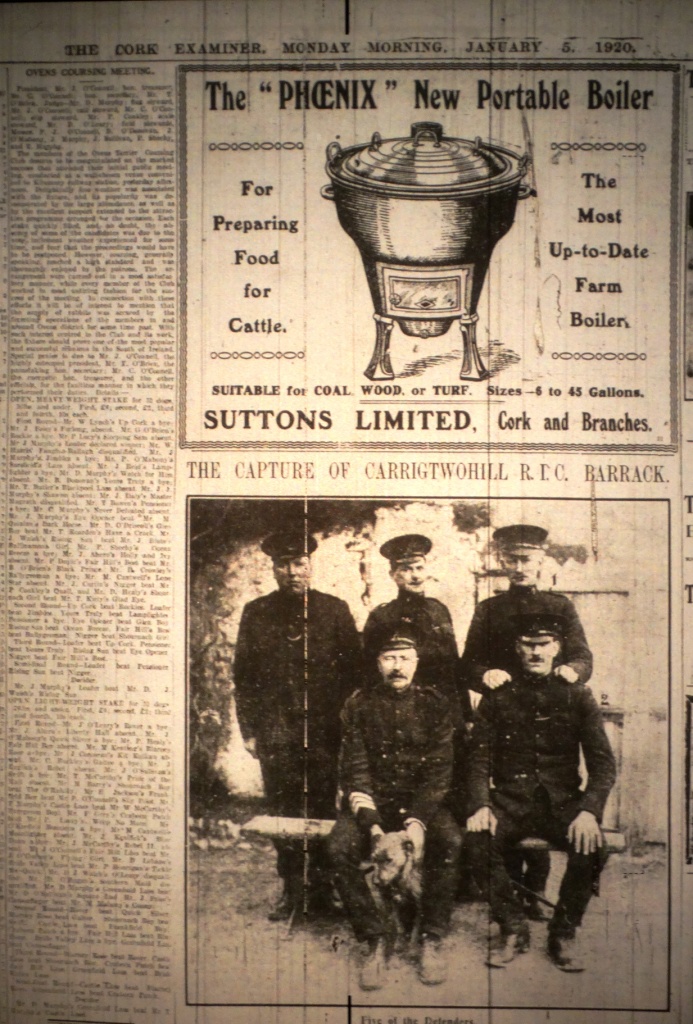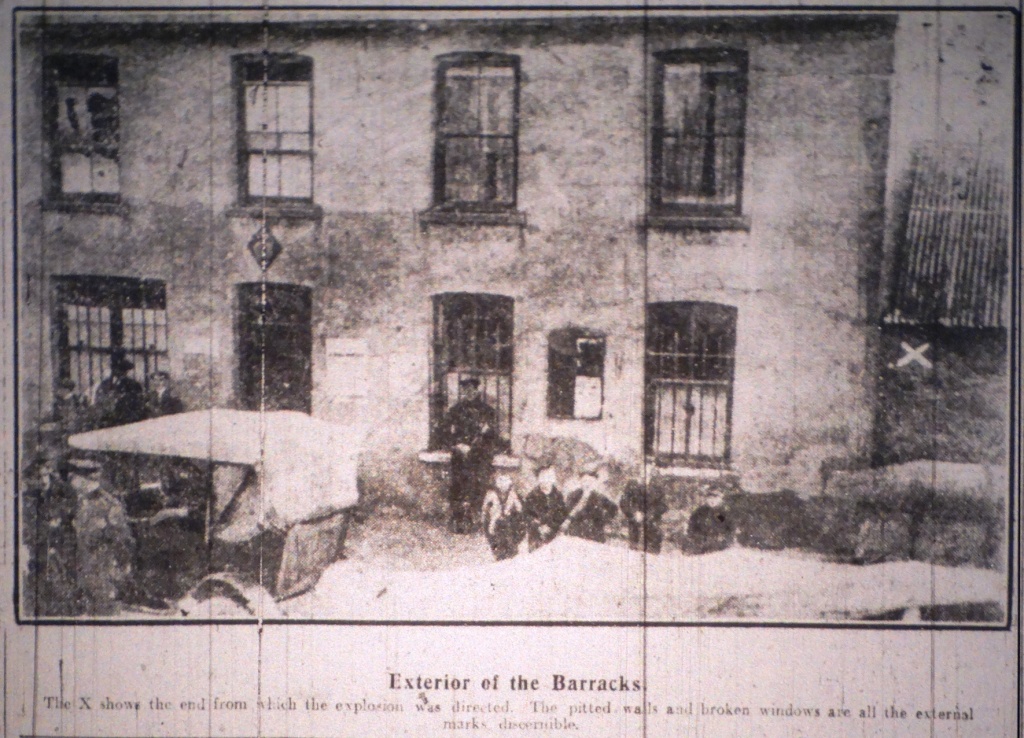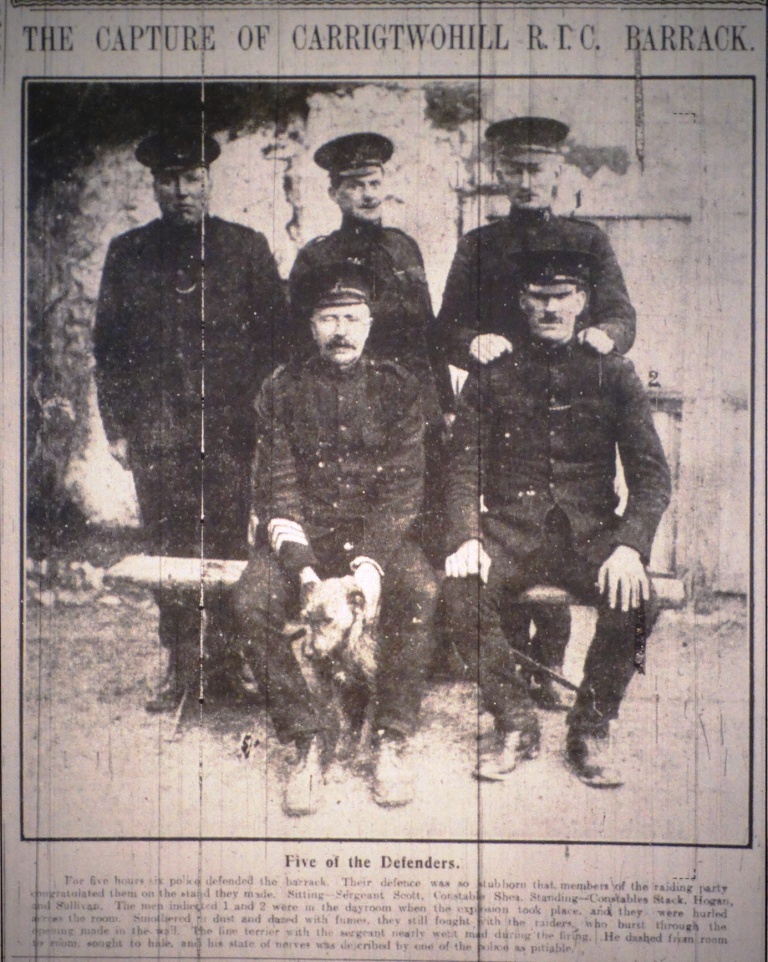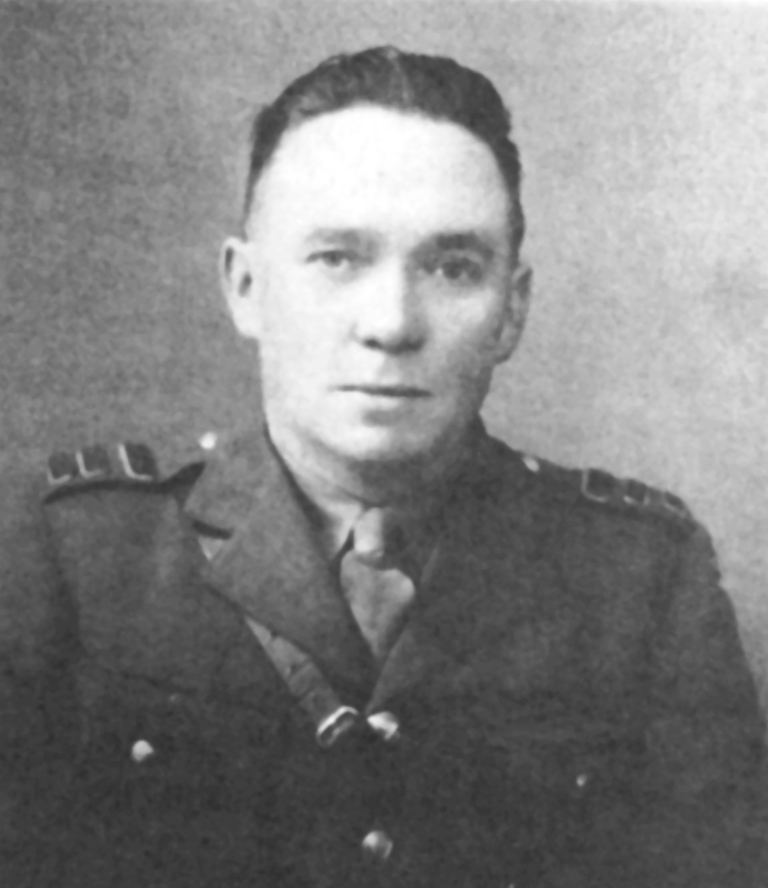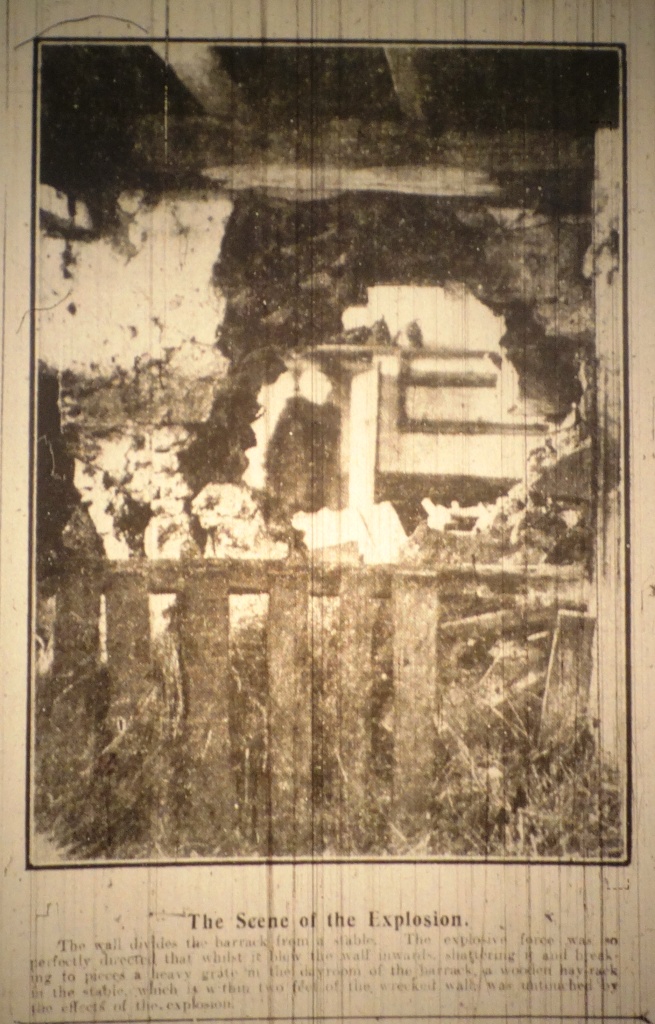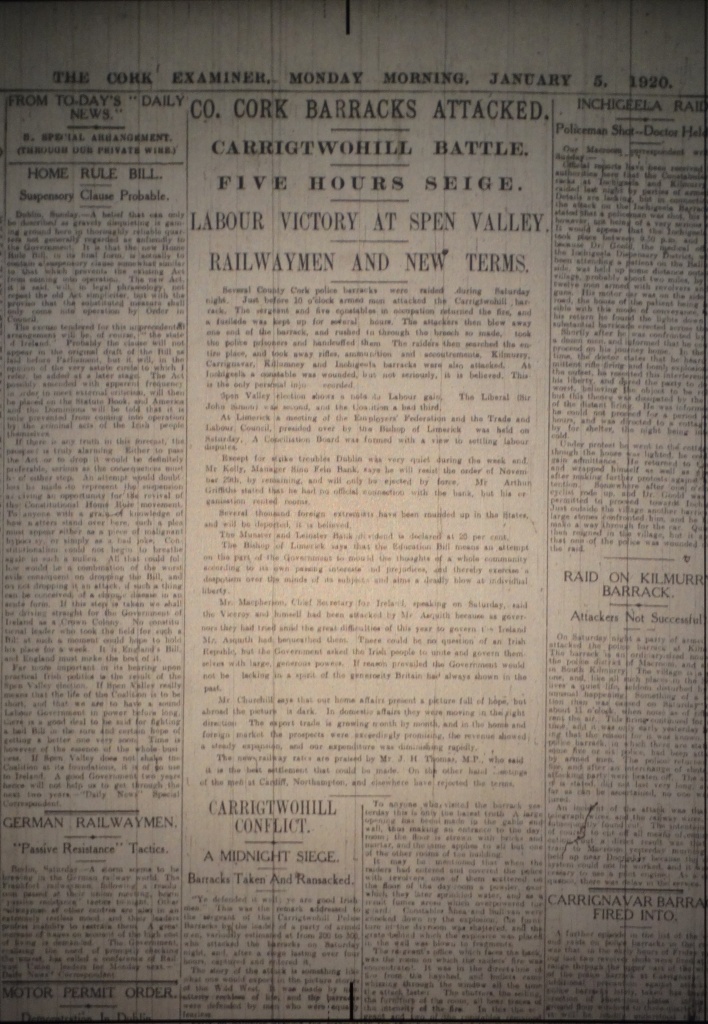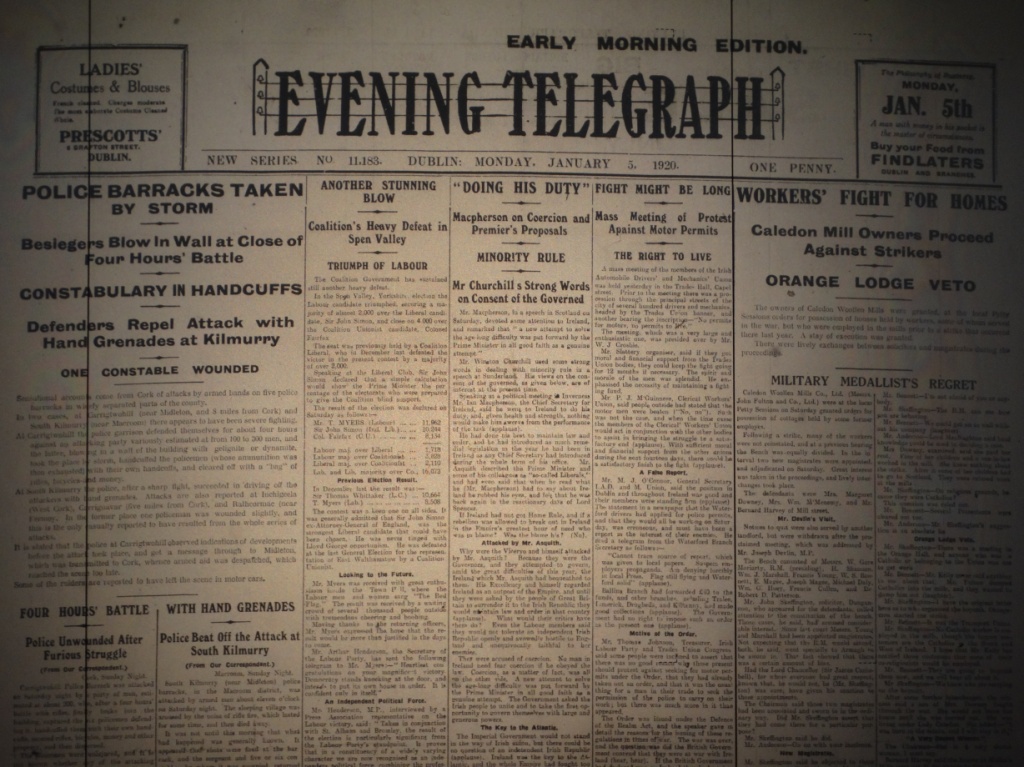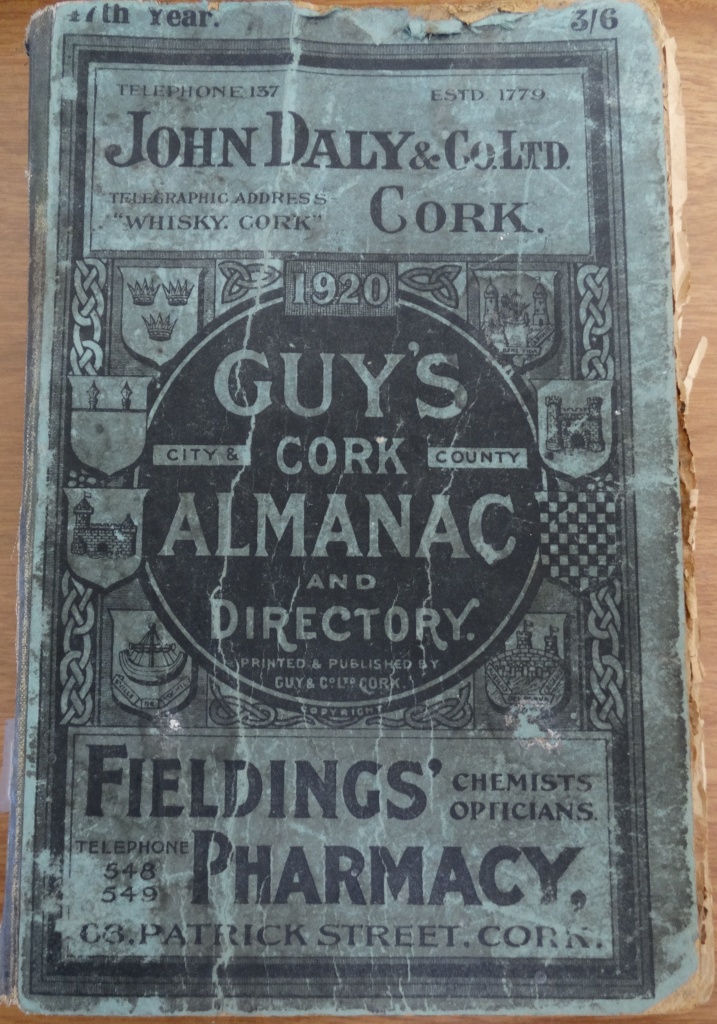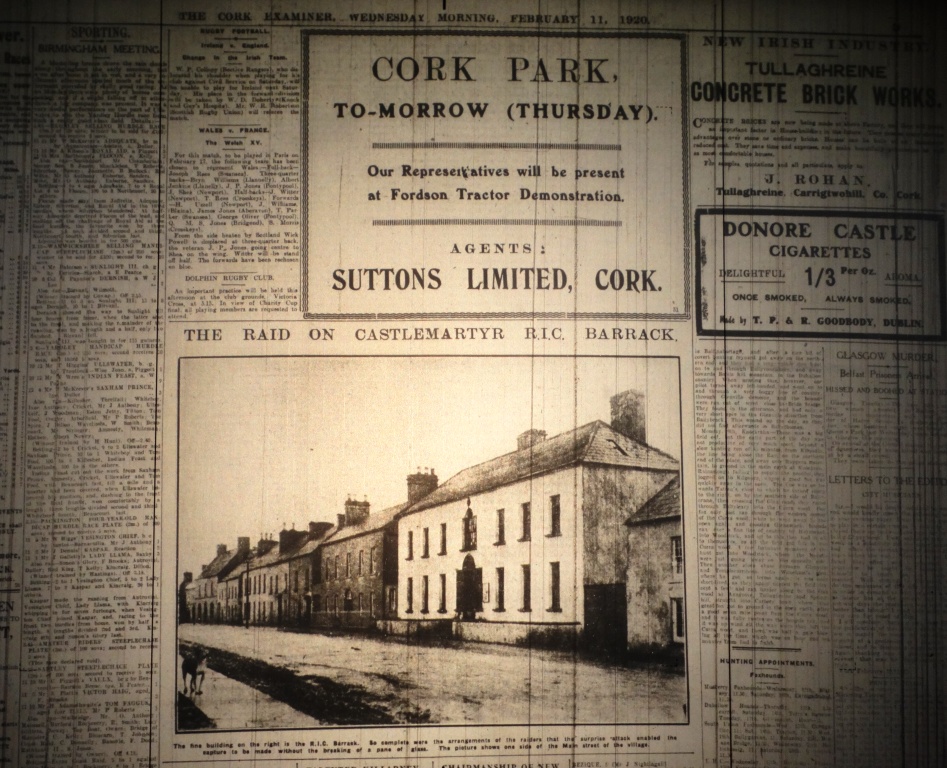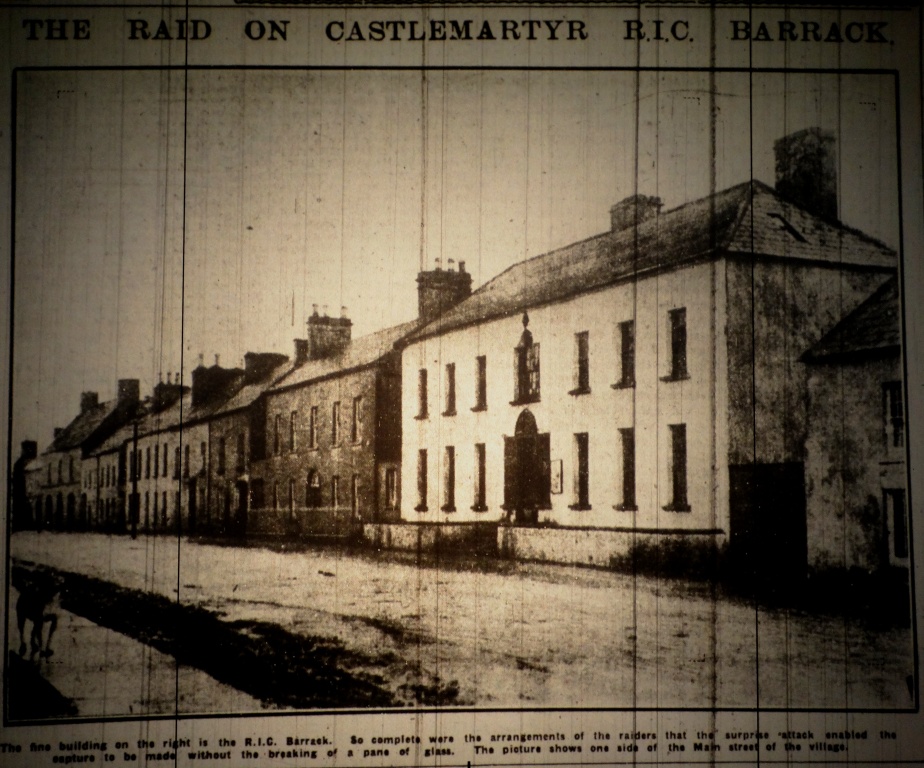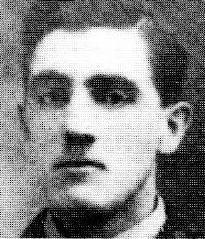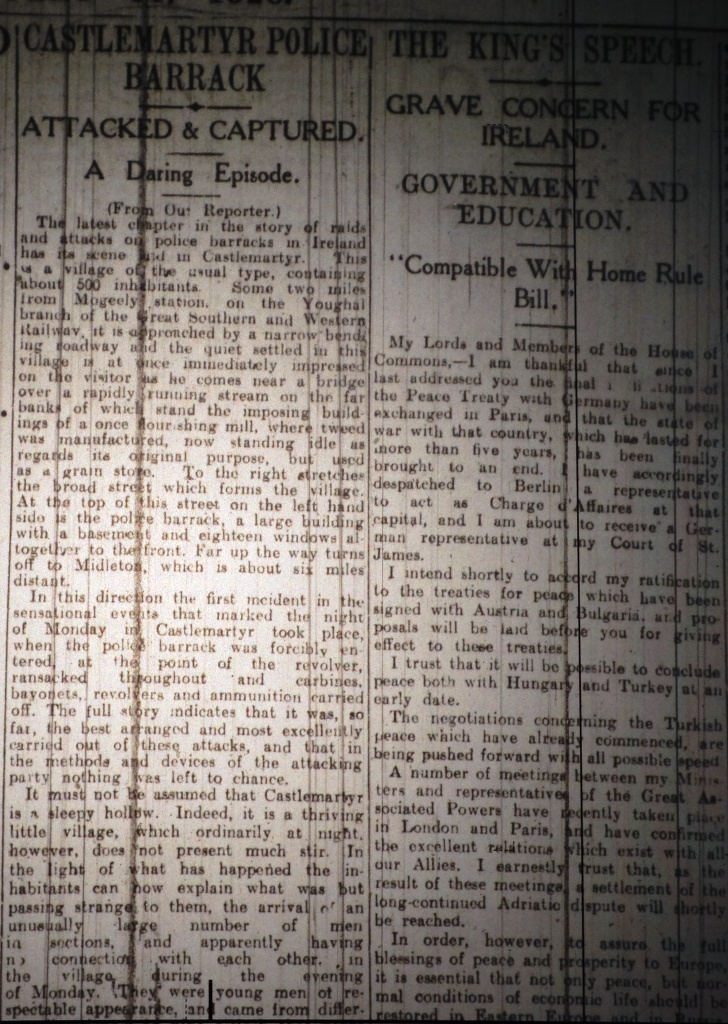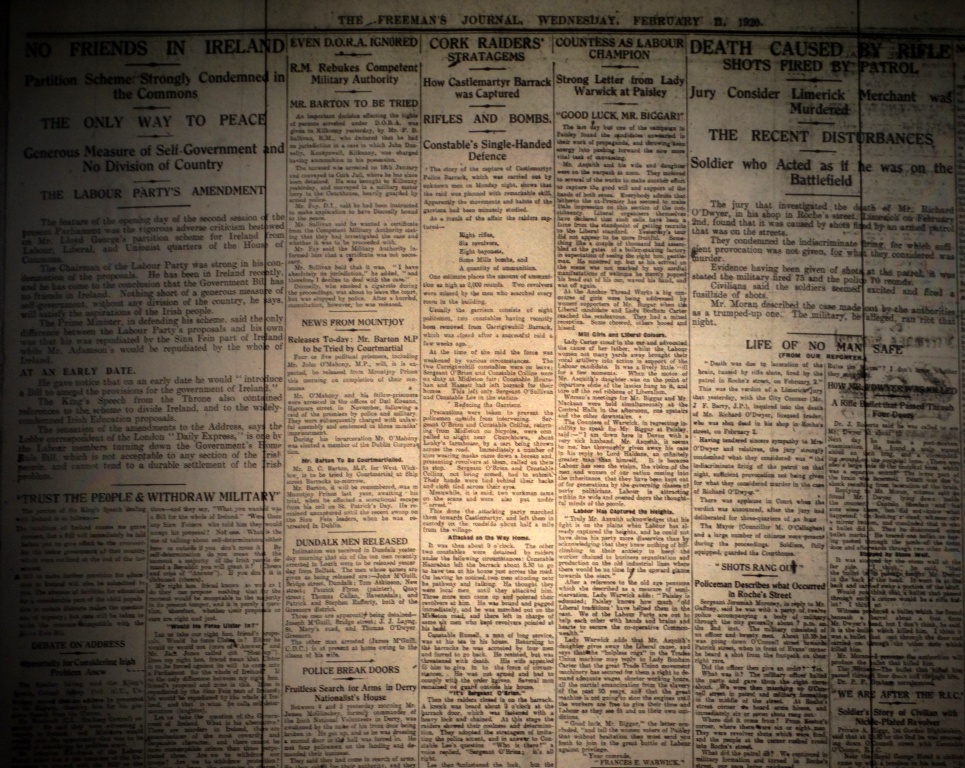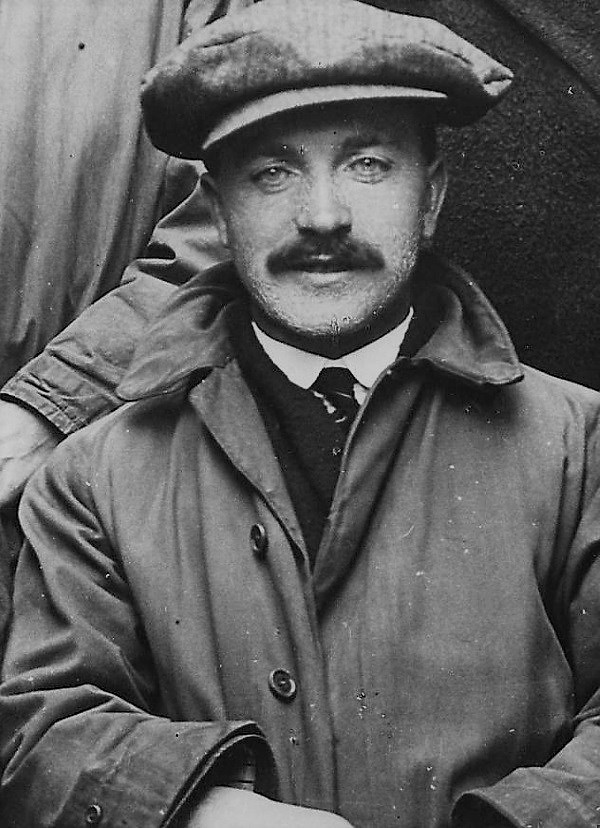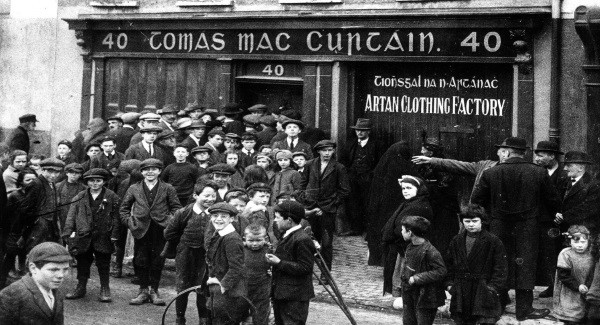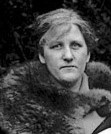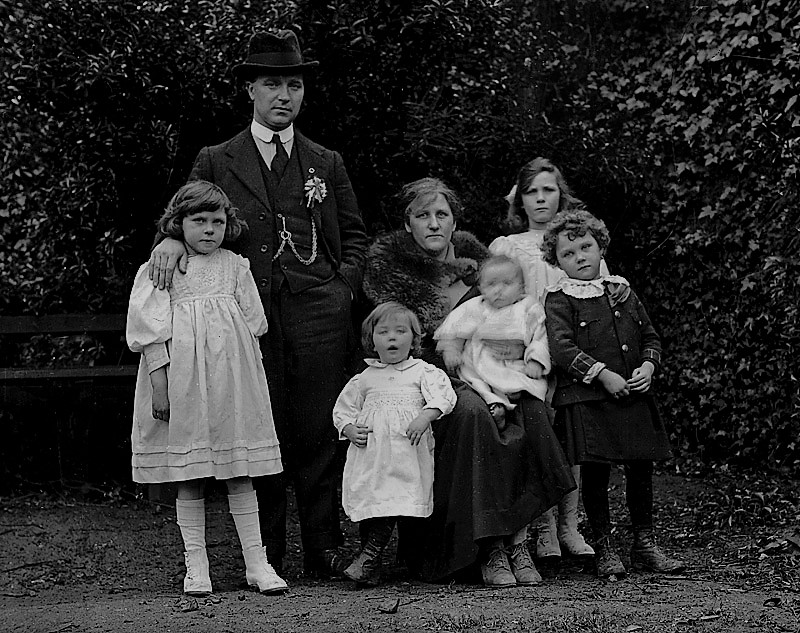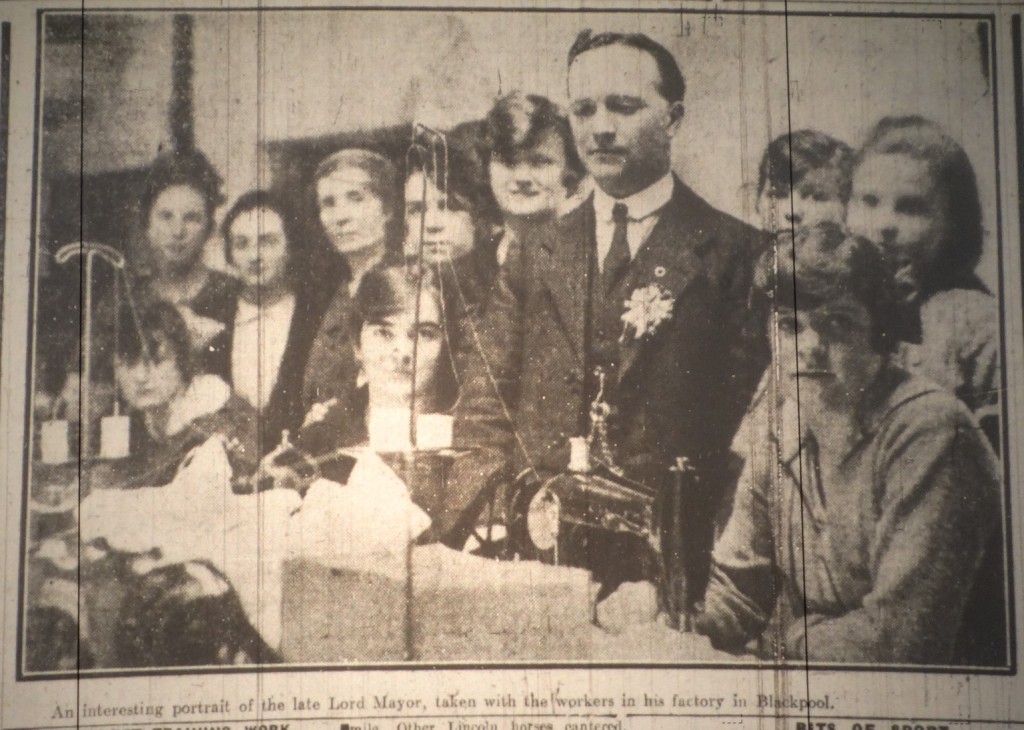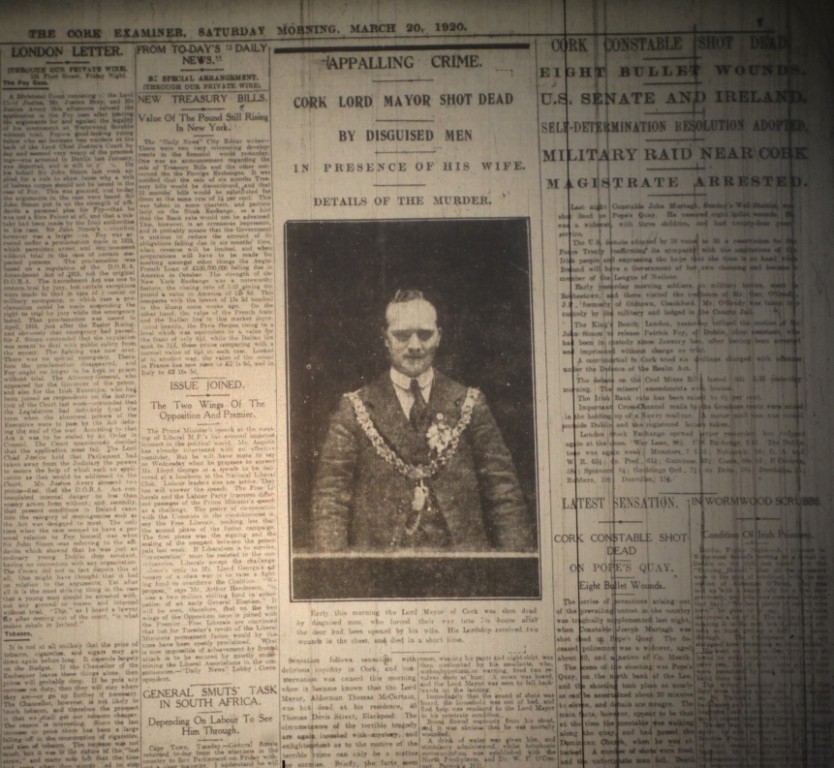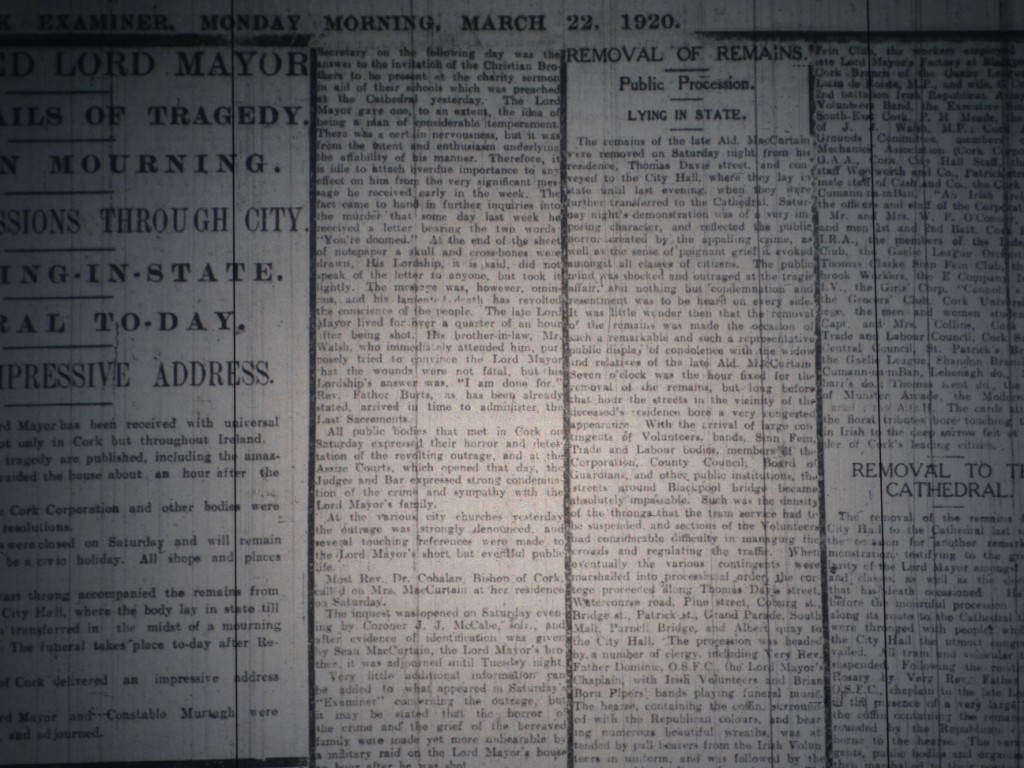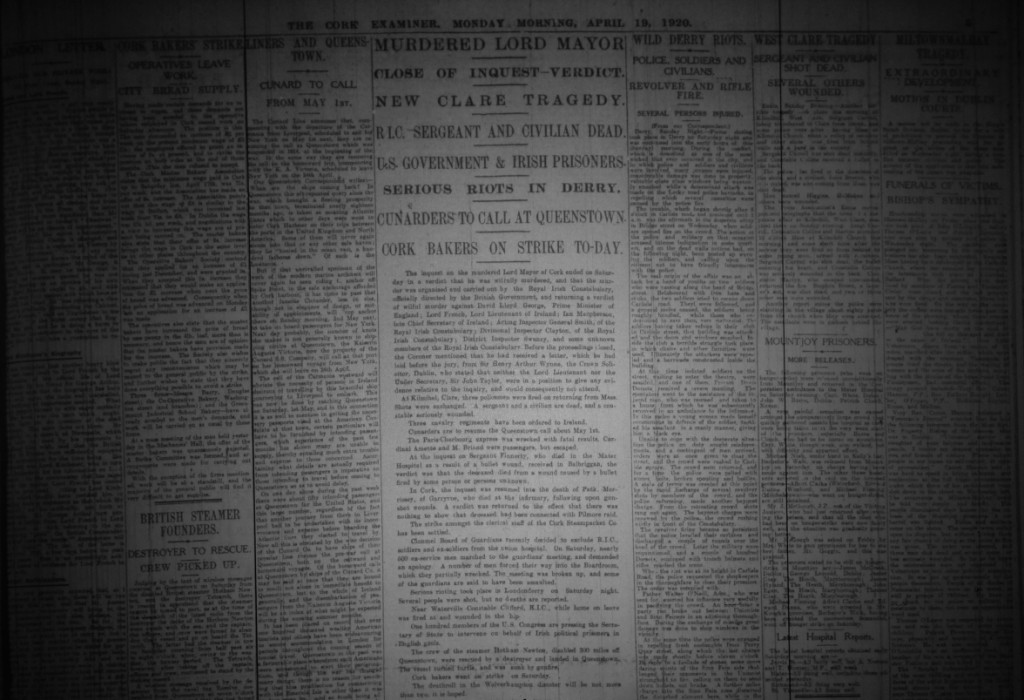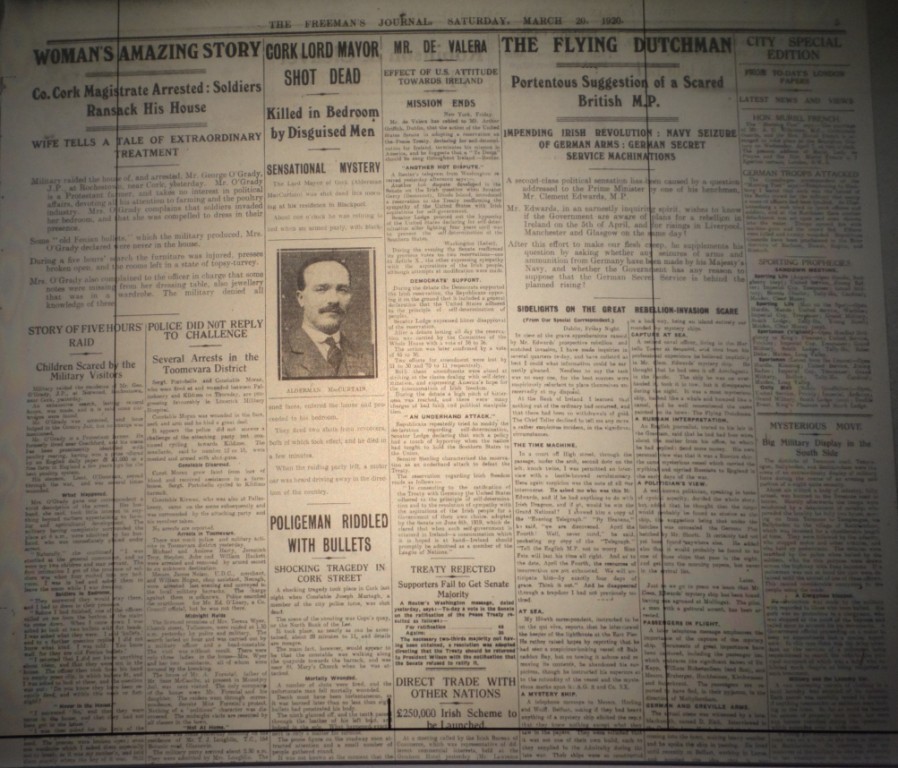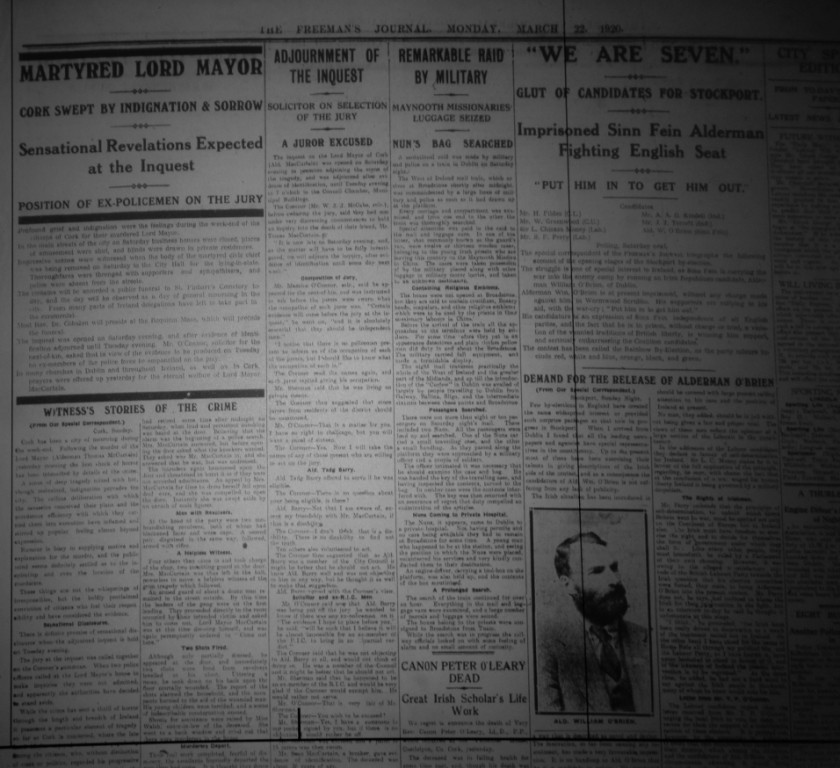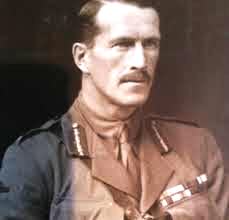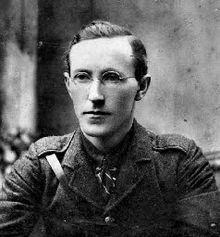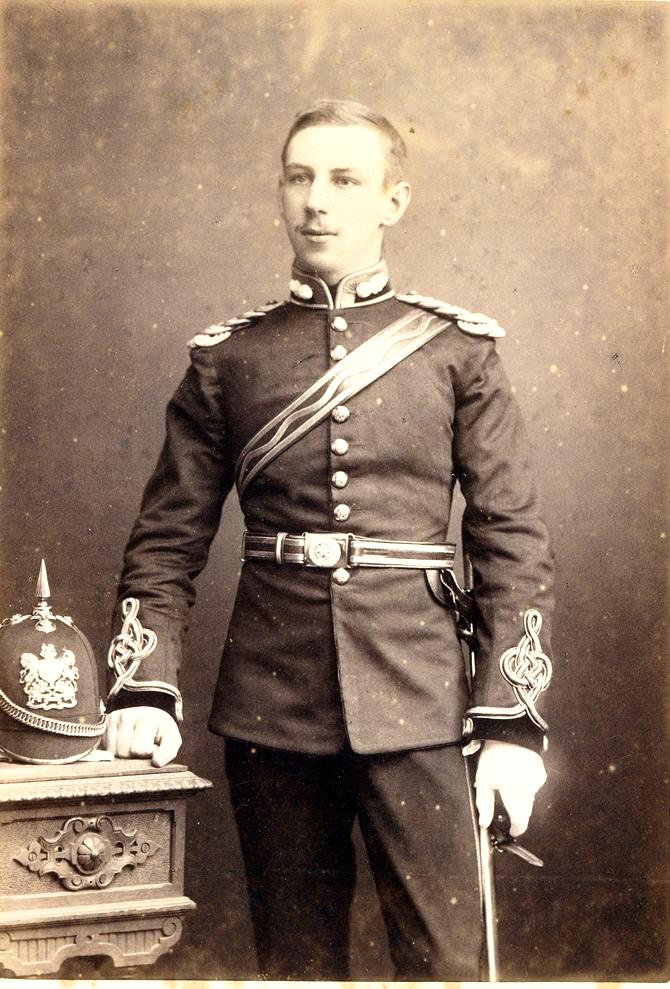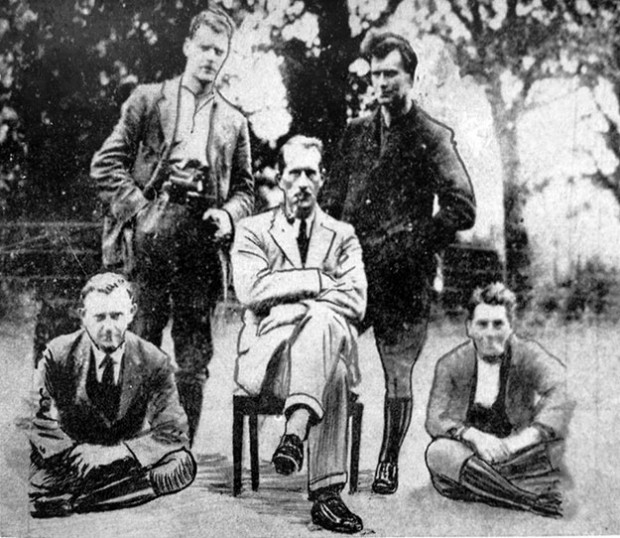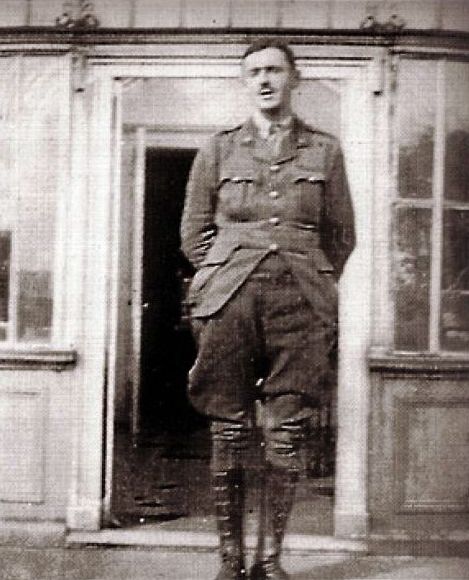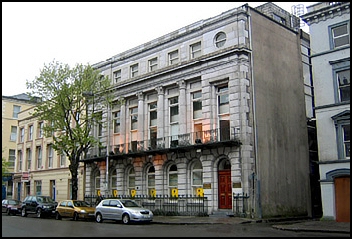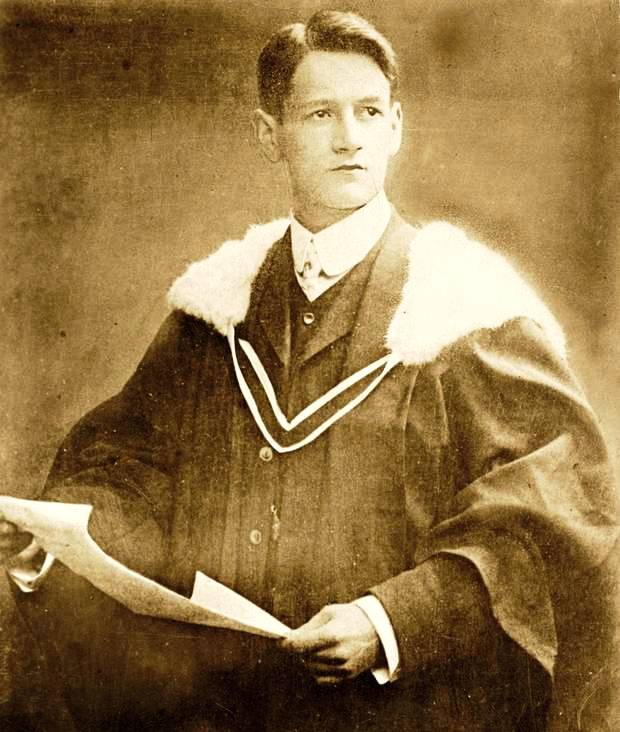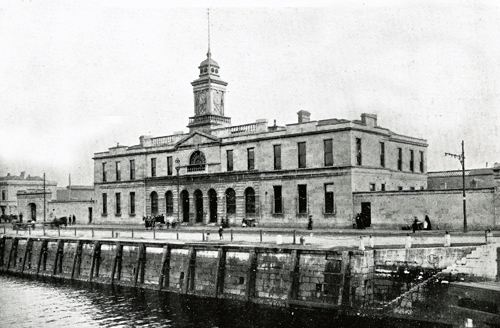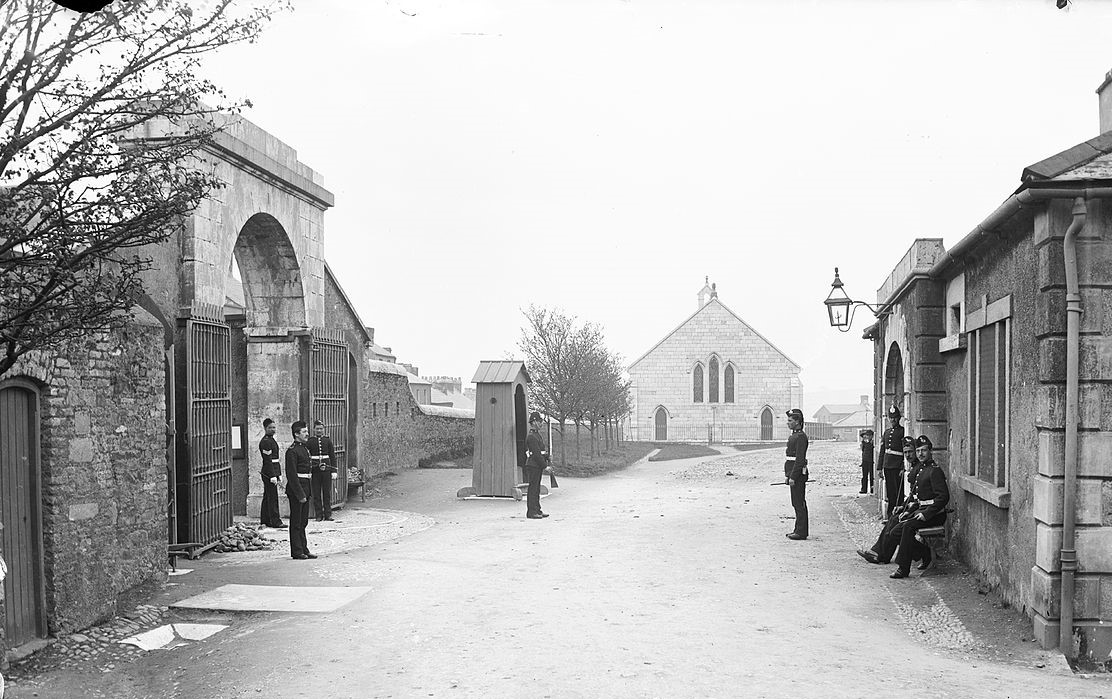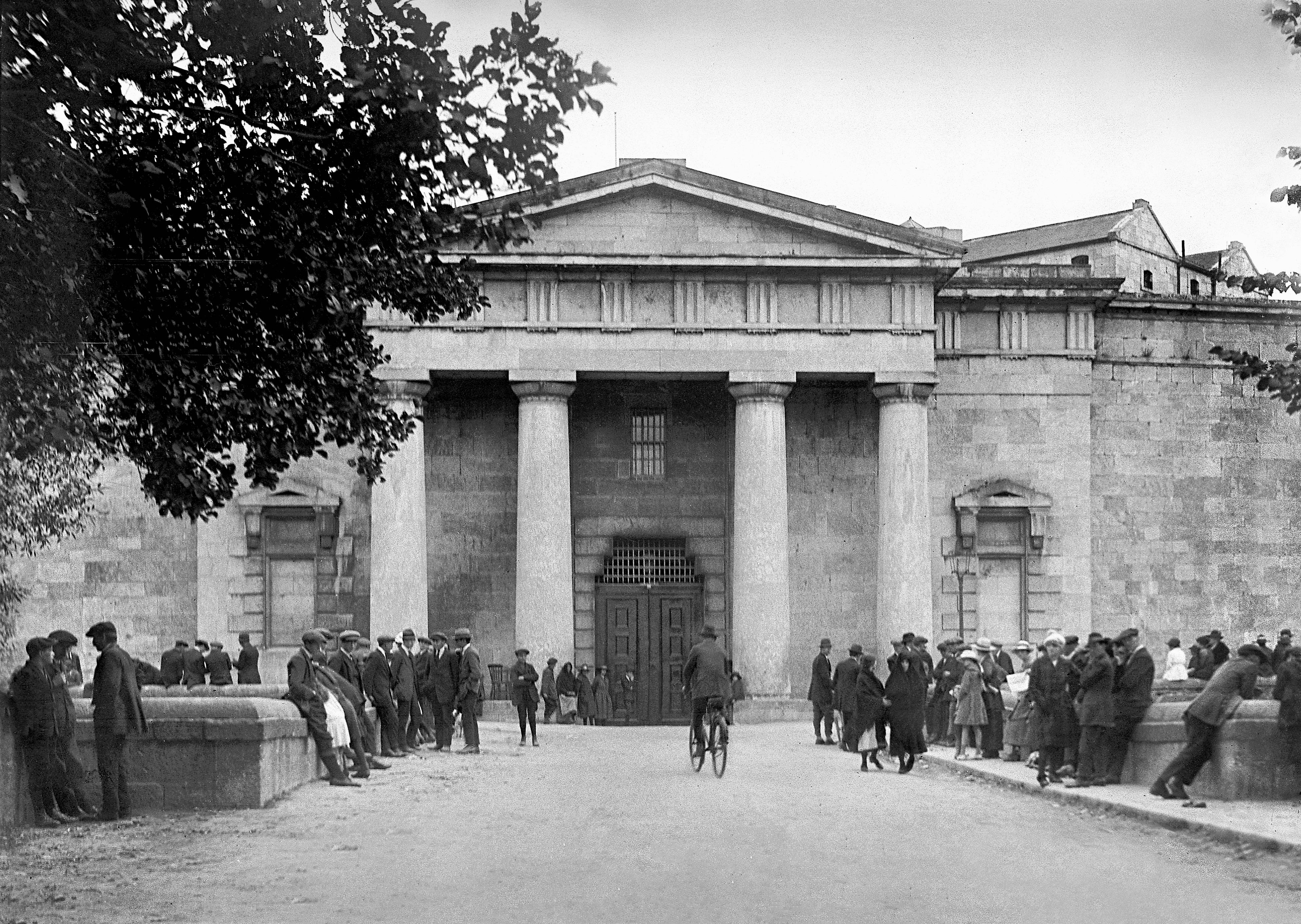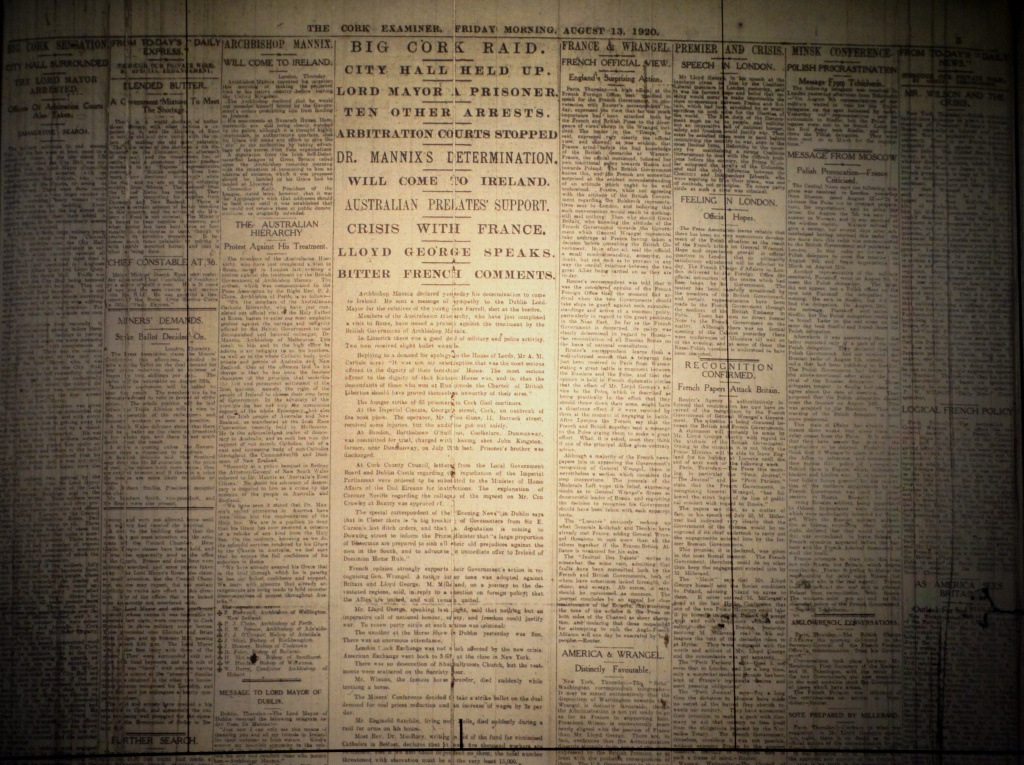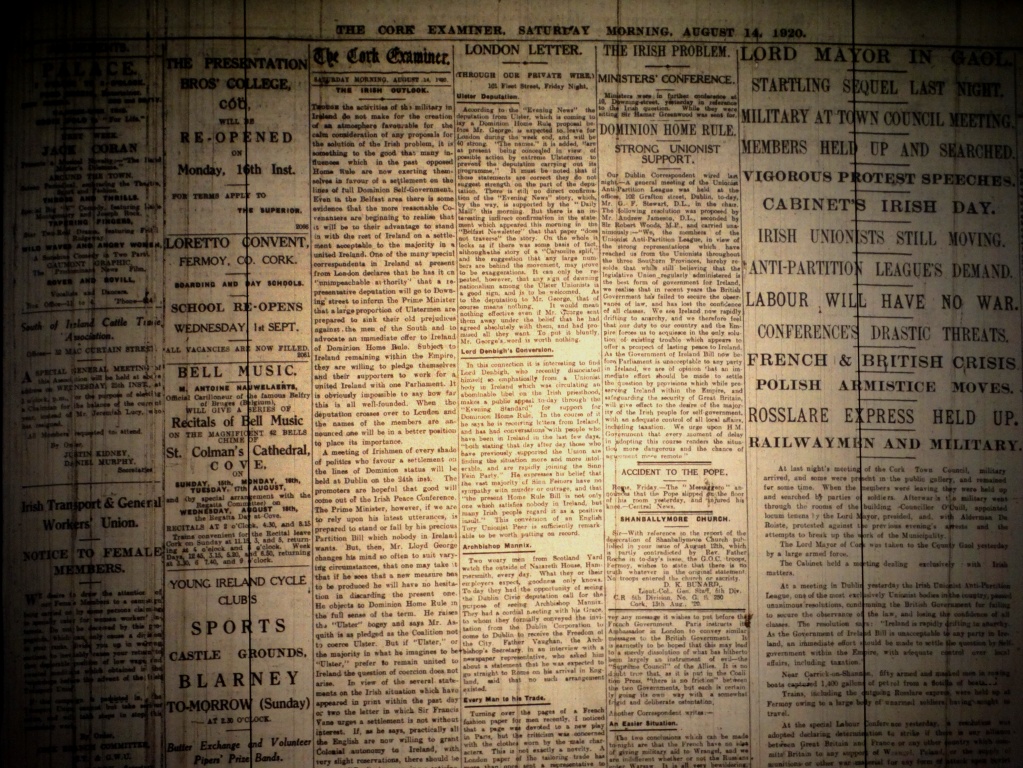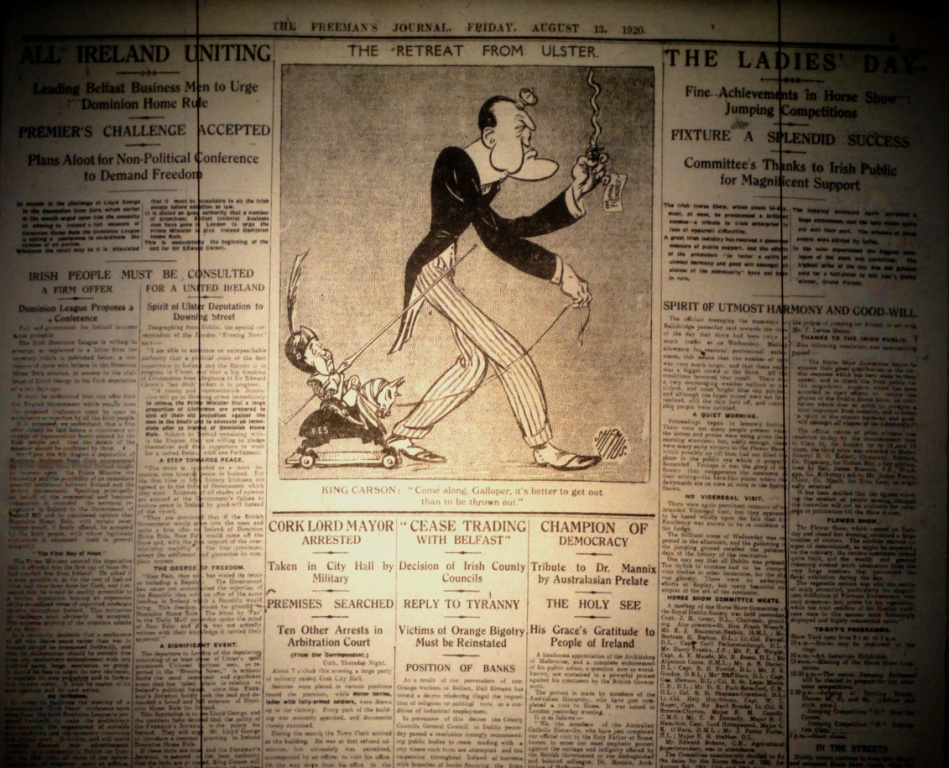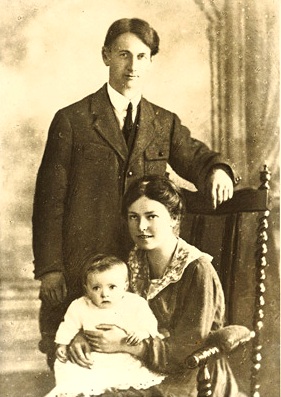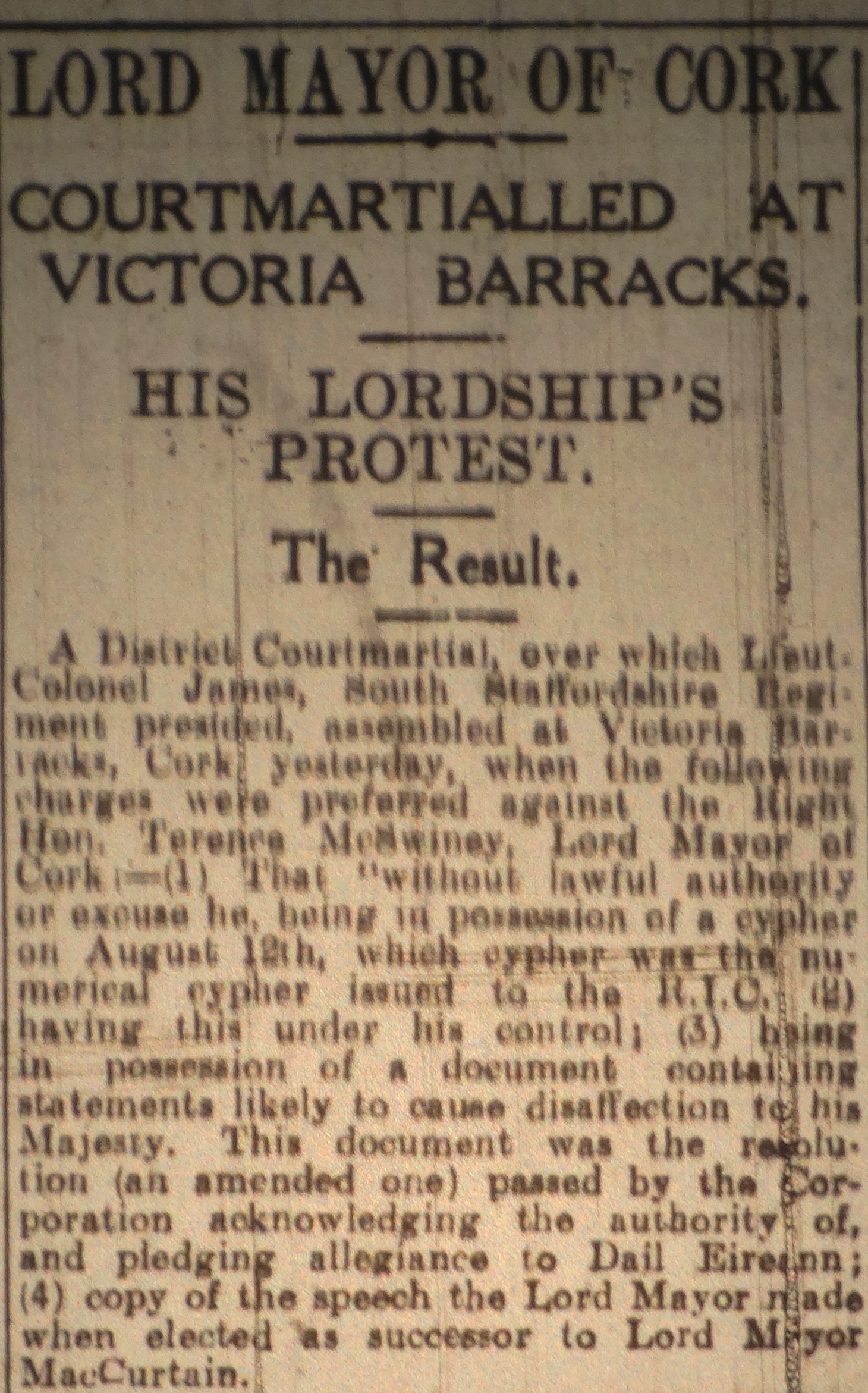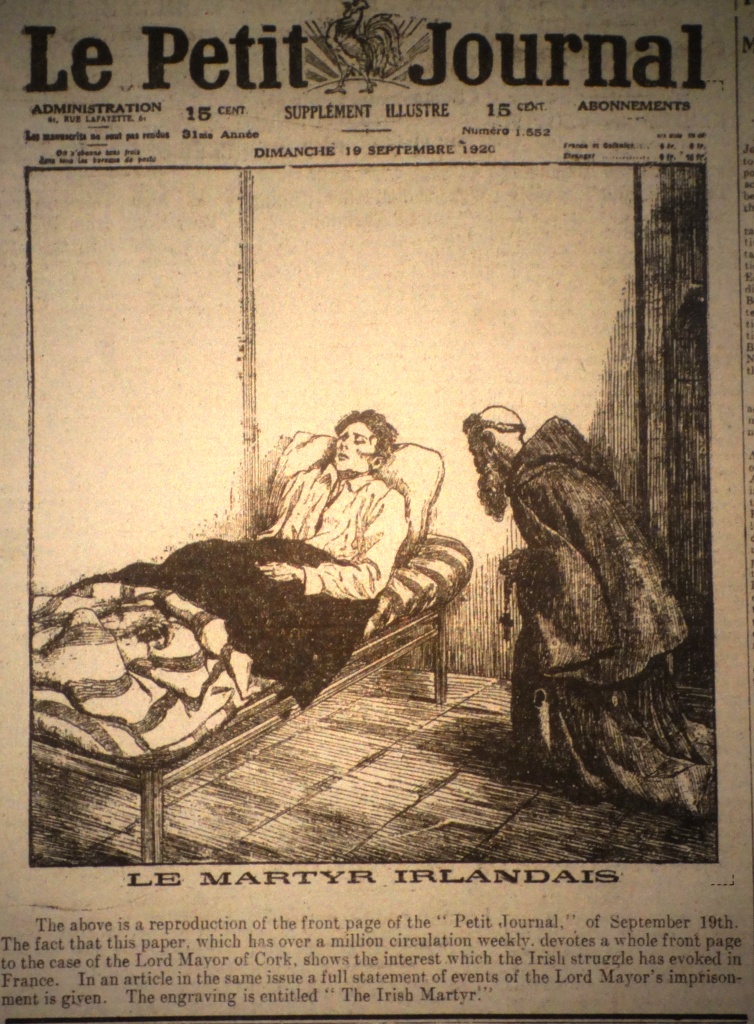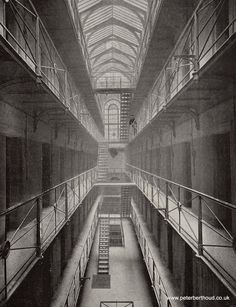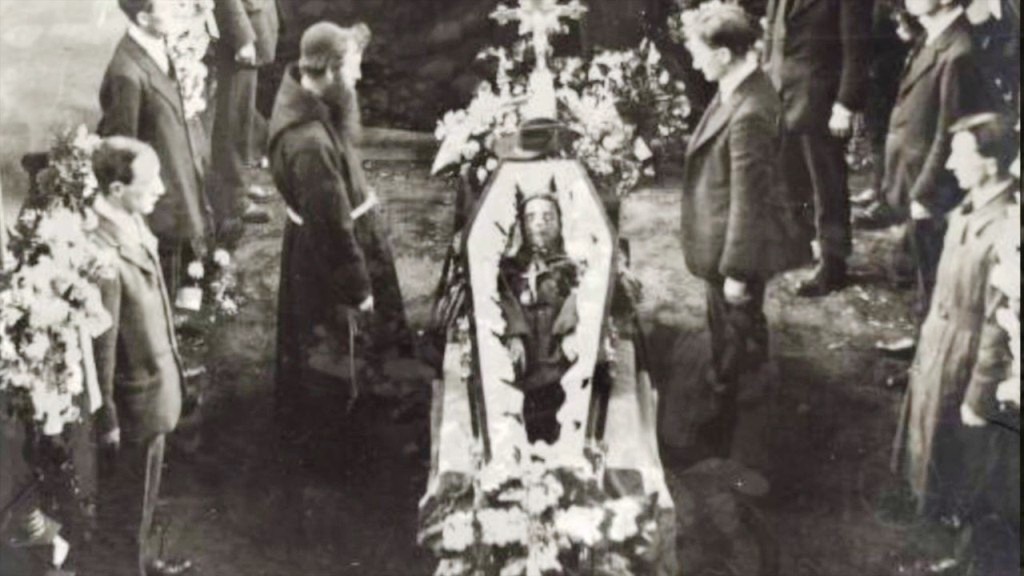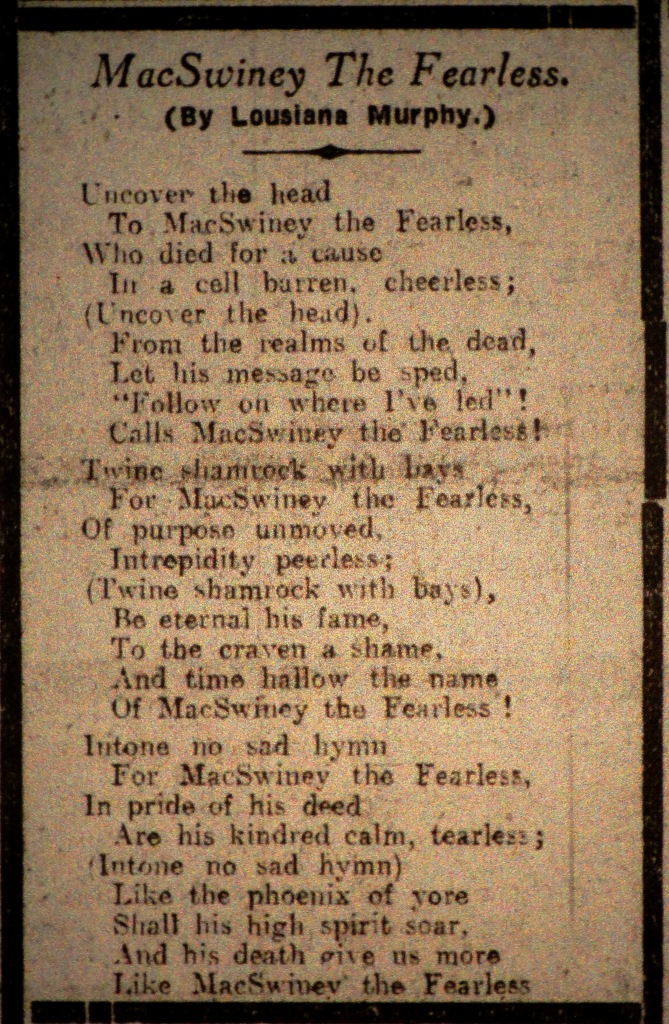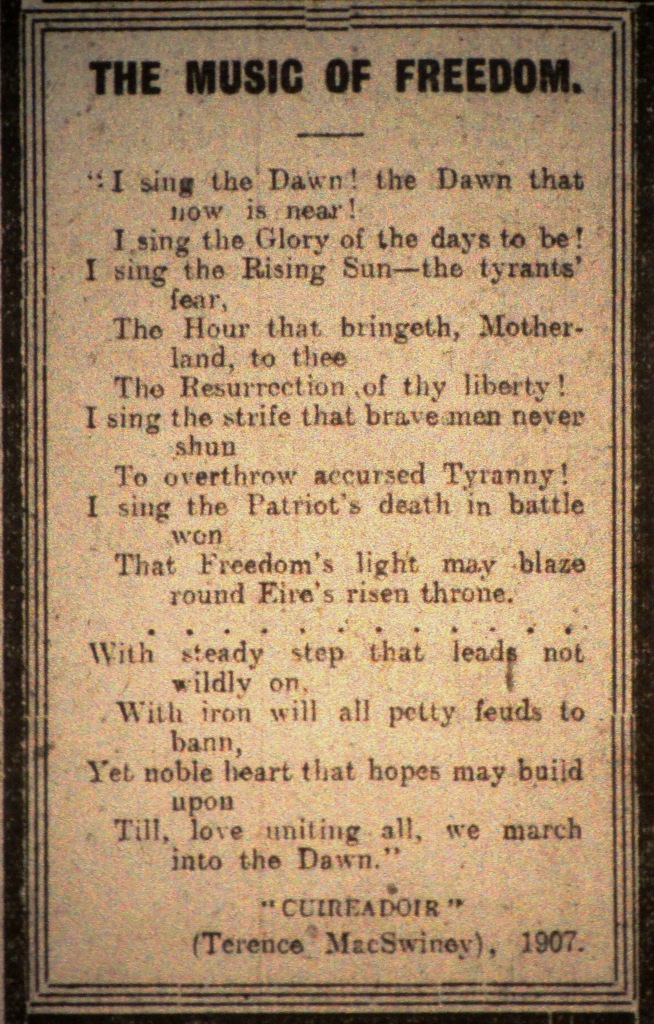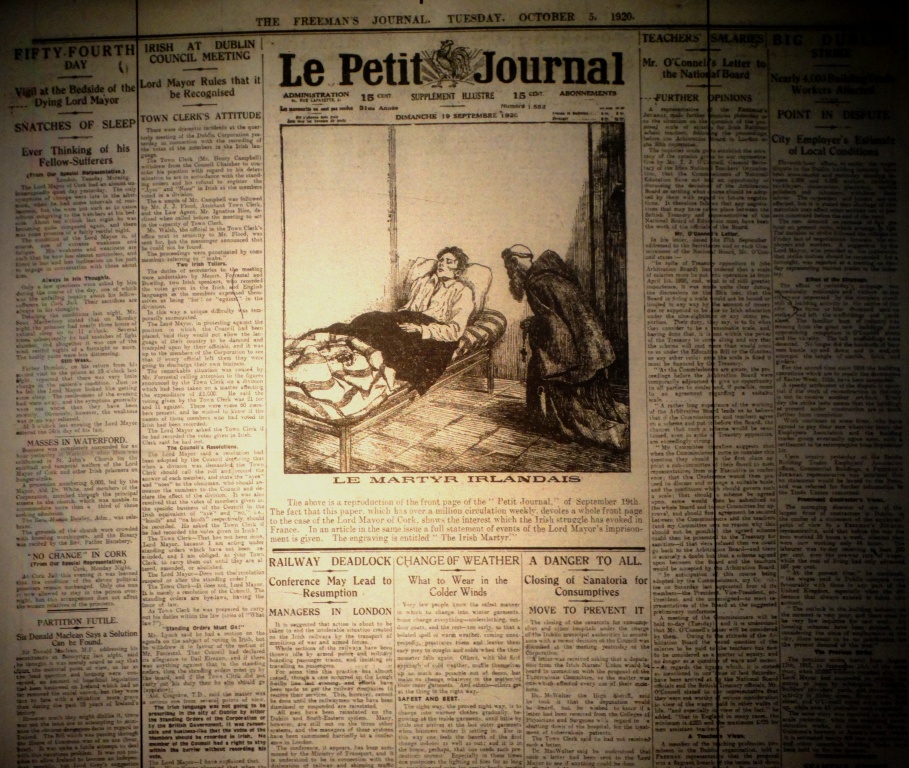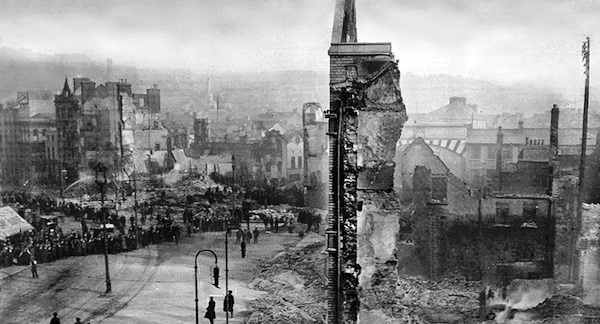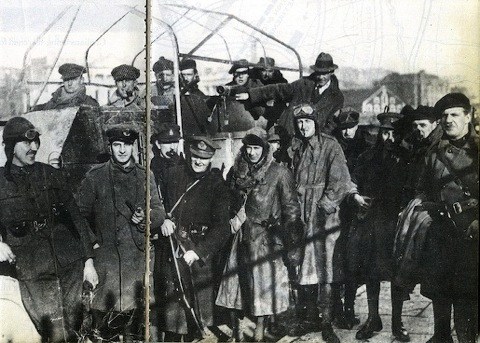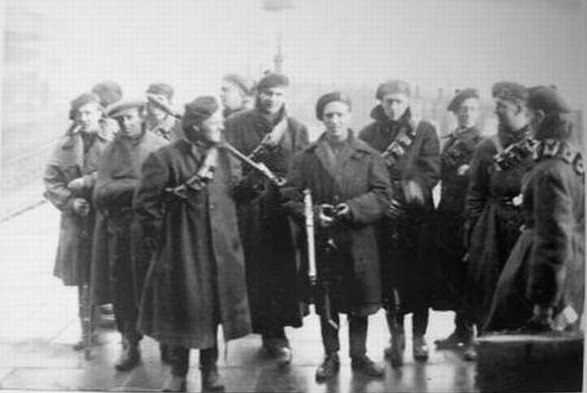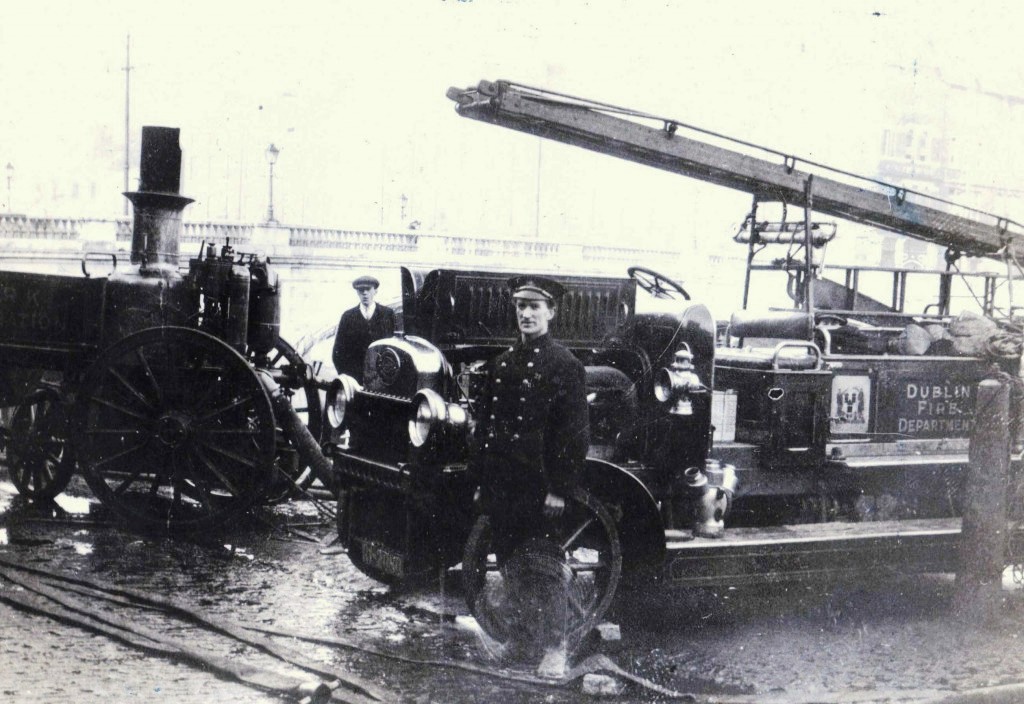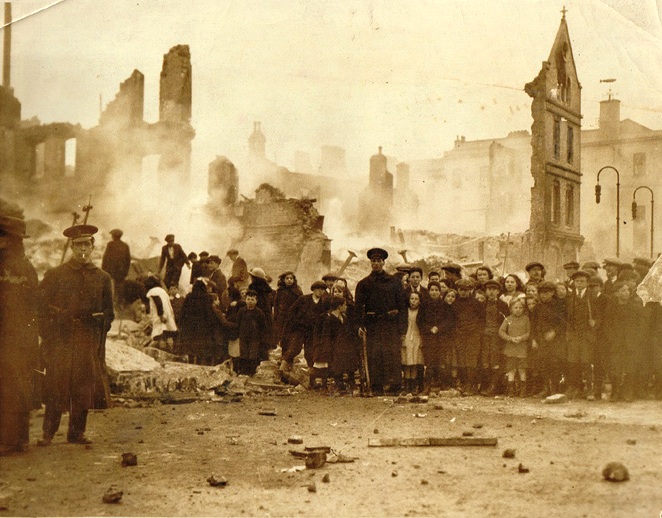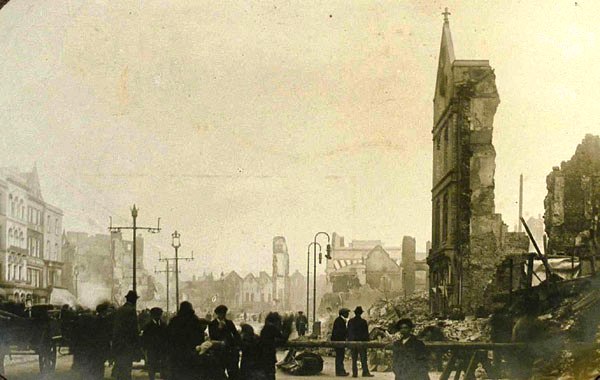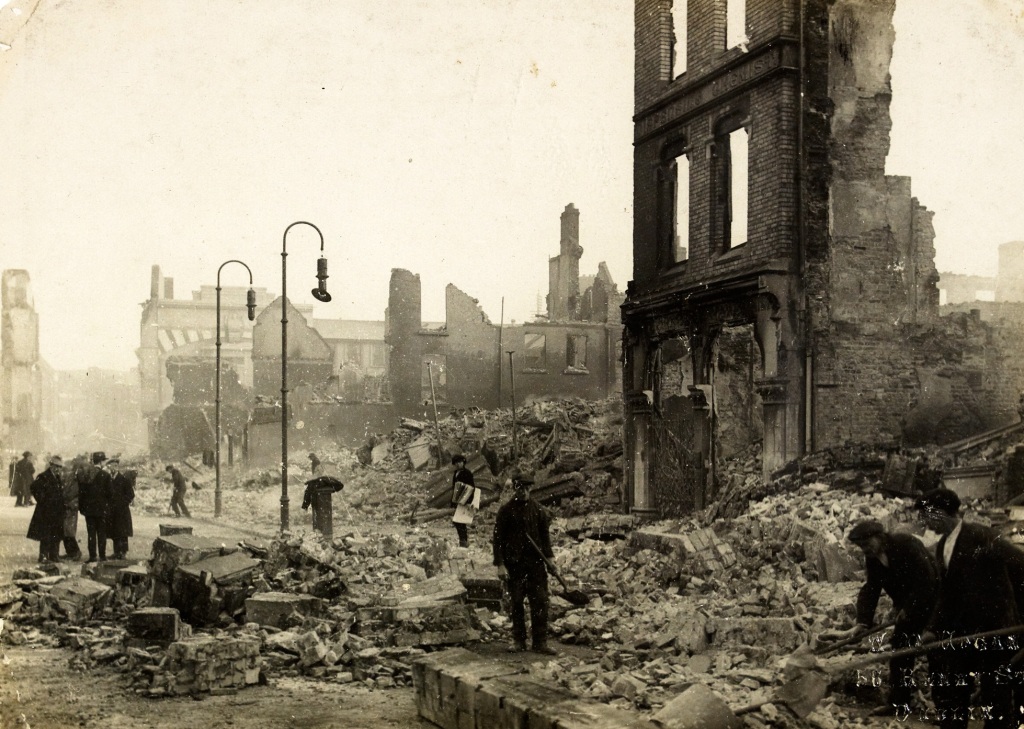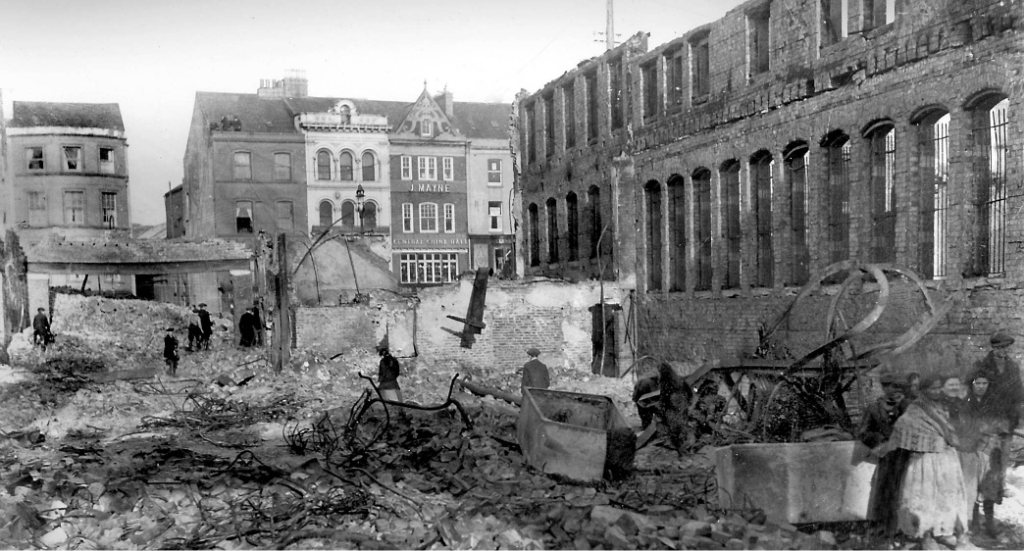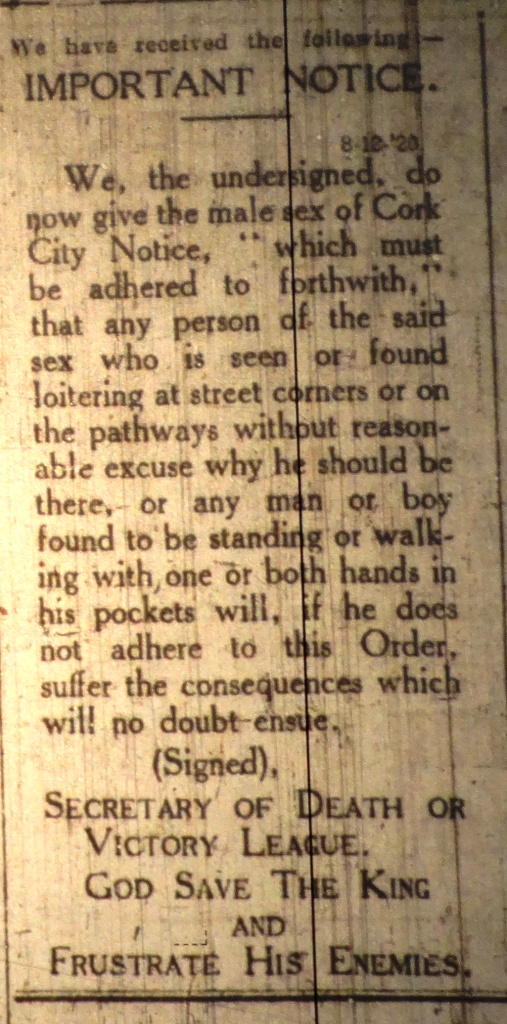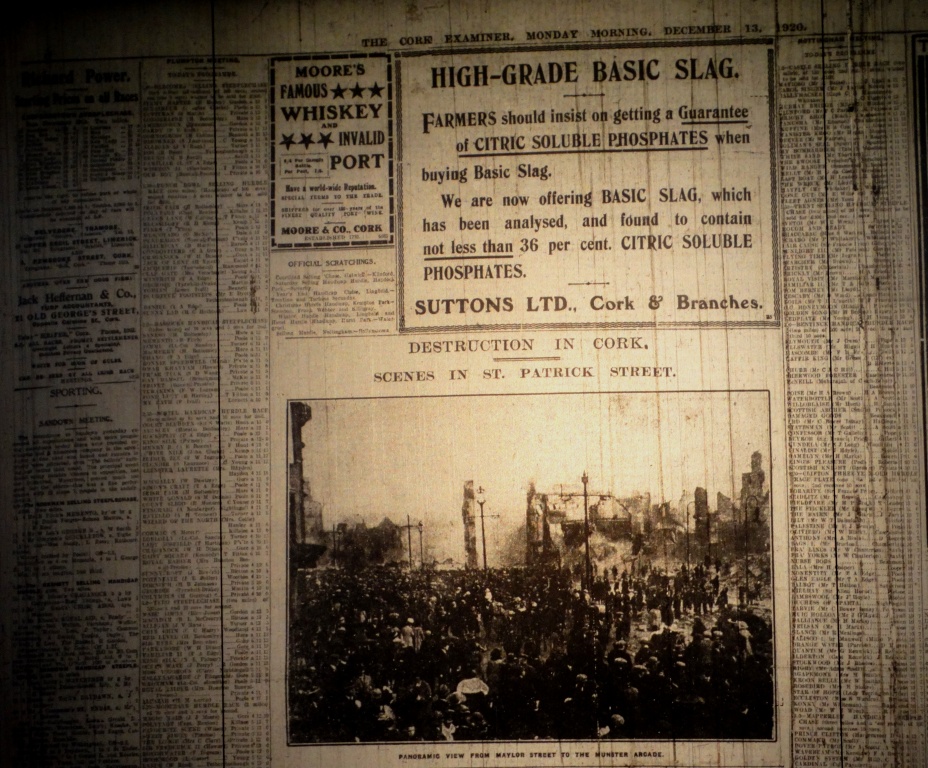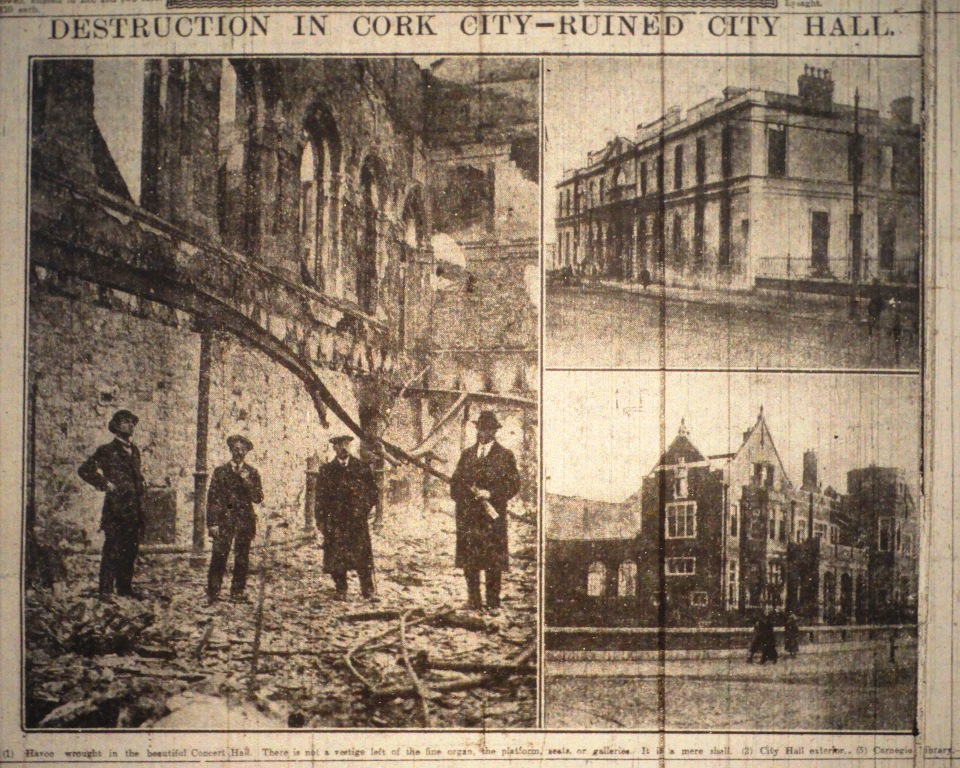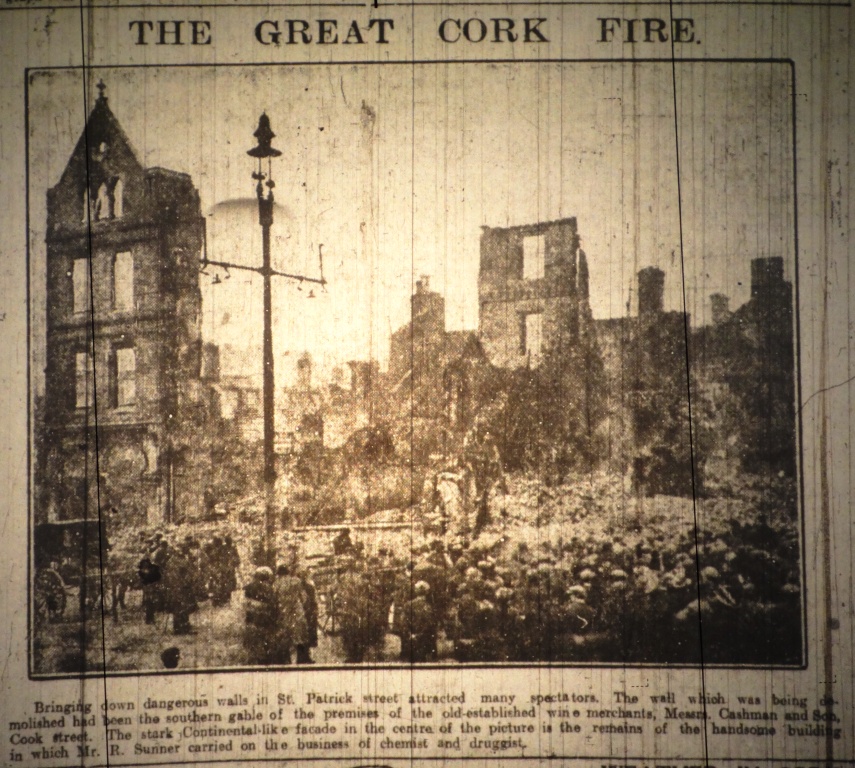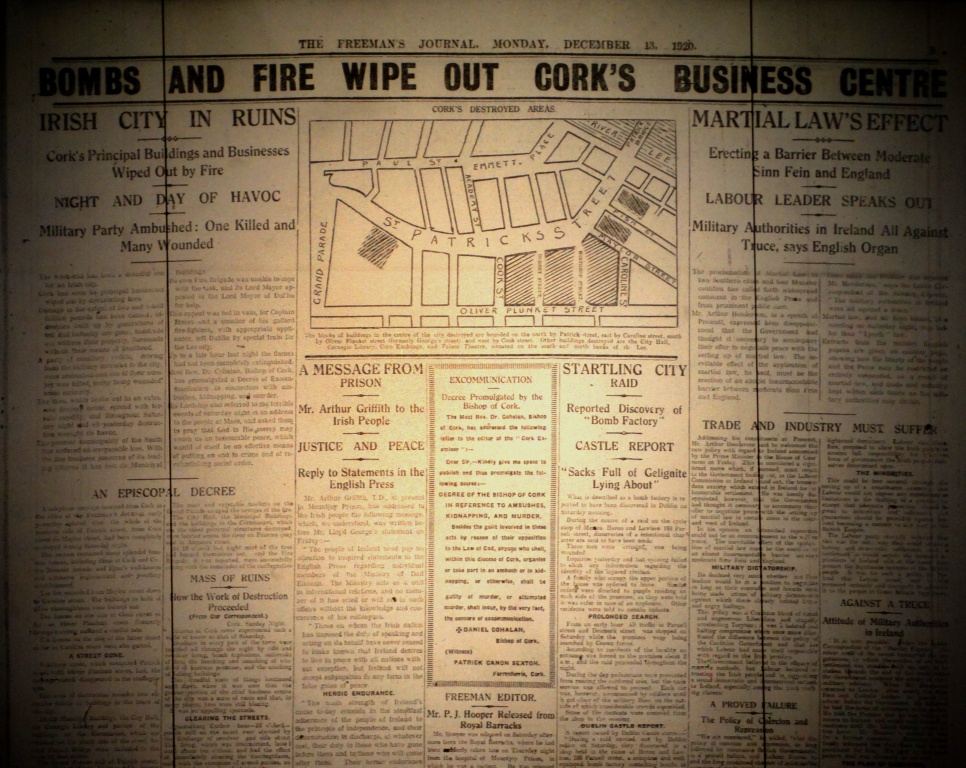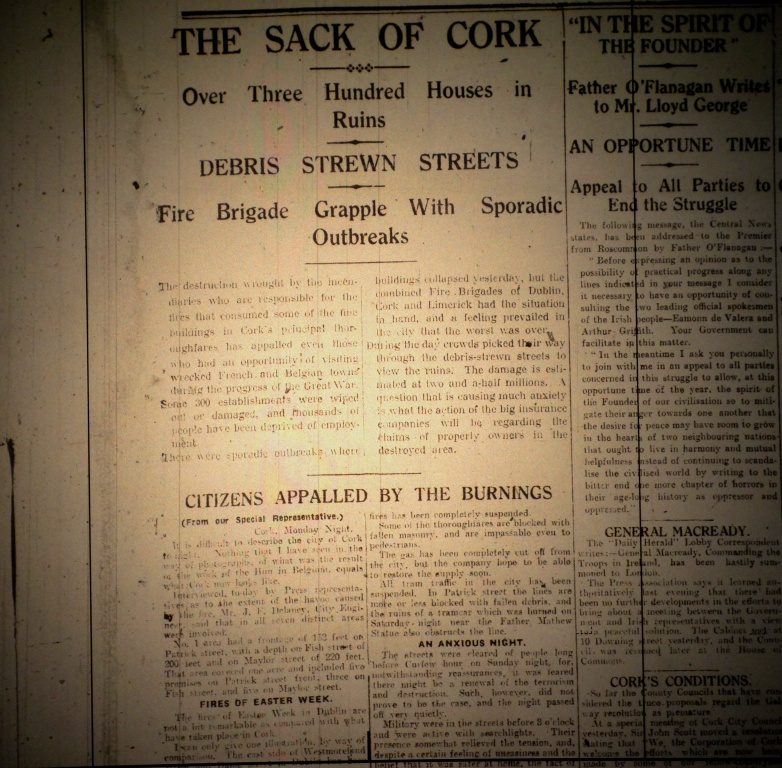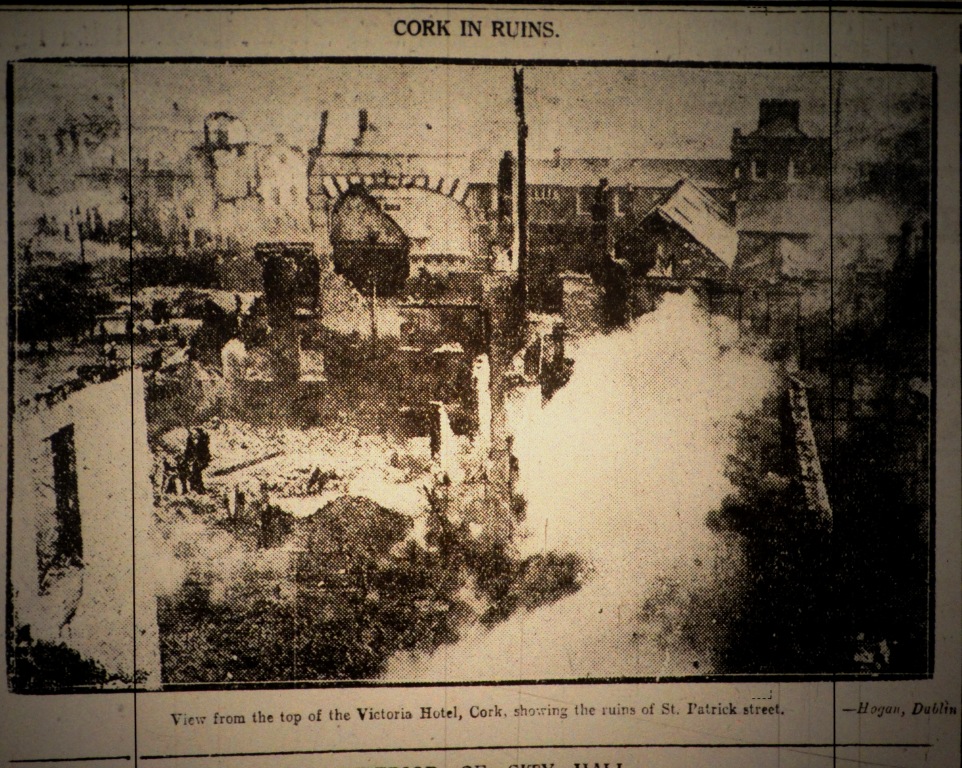-
The Capture of Carrigtwohill RIC Barracks
January 03rd, 1920On the night of Saturday the 3rd of January in 1920 there was an assault lead by Michael Leahy on the RIC barracks in Carrigtwohill. This was part of a larger mission in which three RIC barracks in three different volunteer brigade areas were to be attacked and captured.
The original date set for the assaults on the three RIC barracks was in late December of 1919 but was called off a few days before the attack date because of another operation being held in Dublin. Tomas McCurtain travelled to Dublin to ascertain why the operation was cancelled on such short notice. When he arrived at General Head Quarters he was informed by Michael Collins that an operation to shoot Lord French, Lord Lieutenant and Supreme Commander of the British Army in Ireland, was deemed more important. Tomas McCurtain was handed an automatic pistol by Michael Collins so he could take part in the operation. The operation to shoot Lord French did not proceed and Tomas McCurtain was sent back to Cork and the plan to attack the three RIC barracks was once again given the green light.
When Michael Leahy was informed that the operation to attack three RIC barracks in Cork was to go ahead, he decided that the barracks at Carrigtwohill was a perfect target. There were three active companies in the district within a radius of six miles and the nearest British garrison to Carrigtwohill was at Cobh, which was six miles to the south.
In early January of 1920, the RIC had begun fortifying their barracks against attack by incorporating steel shutters covering the windows. These steel covers had loop-holes cut out of them in order to allow the occupants of the barracks to fire out from secure cover. Michael Leahy has stated in his witness statement (WS: 1421) that he thought that the British had become aware of the planned attacks on multiple barracks and that was why they were fortifying their positions. Many men in various companies were aware of the plan to attack multiple barracks and that it was possible someone had spoken of these plans and the information had made it to the British forces.
-Carrigtwohill RIC Barracks
The RIC barracks in Carrigtwohill was a stone-built building with a slate roof. It was located on the main street of the village and was attached to a row of houses. The building had been recently fortified with steel plate covering the windows on both the front and rear of the building. The information on how many RIC personnel stationed at the Carrigtwohill barracks during the attack varies with each resource. The Cork Examiner states that there were only four Constables and one Sergeant present on the day of the attack. The Evening Telegraph stated that there was only five RIC personnel also, but the Telegraph seems to have relied heavily on the Cork Examiner's information, as its article is almost identical. The information obtained by the Cork Examiner was taken from the RIC Sergeant on duty in Carrigtwohill during the attack.
-RIC Personnel
The inconsistencies in the number of RIC present at the barracks can also be seen in the witness statements on the Bureau of Military history website of four different volunteers who took part in the attack. In Michael Leahy’s witness statement (WS: 1421) he states that there was ten men under one Sergeant garrisoned at the barracks. This is double the amount reported by the local newspapers. We can see from three other Volunteers witness statements that most of them agreed with Michael Leahy’s estimate of about ten RIC personnel present on the night of the attack. John Kelleher states one Sergeant and seven Constables (WS: 1456), Michael Kearney states one Sergeant and eight Constables (WS: 1418) and Patrick J. Whelan states there was one Sergeant and nine Constables (WS: 1449). All agreed that there were more than just five RIC personnel garrisoned at Carrigtwohill barrack on the night of the attack.
The three volunteer companies involved in the attack were Cobh, Midleton and Knockraha. Michael Leahy decided to attack the Carrigtwohill barracks because the barracks was right in the middle of all three companies, and all three companies were the best armed in the battalion. The local volunteers within Carrigtwohill were not used because they may have been identified by the RIC defending the Barracks.
On the morning of the attack Michael Leahy instructed Diarmuid Hurley, Captain of the Midleton Company, to have all available men assembled at 10.00 pm in the Carrigtwohill schoolhouse, situated on a by-road on the south side of the village. Michael Leahy then instructed Martin Corry, Captain of the Knockraha Company, to parade his company of about 35 volunteers at Knockraha at 9.00 pm and wait for further instructions. On Saturday afternoon Michael Leahy then arranged a meeting at his home in Ballywilliam, Cobh, for the Officers of the Cobh Company. The Volunteer Officers who attended this meeting according to Michael Leahy’s witness statement were Captain Ned Stack, lieutenants Daithi O’Brien, Jack O’Connell and Jack Stack. It was agreed at this meeting that about 40 Cobh Volunteers would take part in the assault on Carrigtwohill Barracks. The dispatch carrier for the operation was also chosen at the meeting, he was Jack Higgins of Cobh. The Cobh Officers were also instructed to use a motor vehicle to transport rifles and grenades to Carrigtwohill for the operation, and to make a speedy exit with any firearms and ammunition captured.
In order to cut off the village of Carrigtwohill for the operation, 30 of the Cobh Volunteers cut down trees and put up road blocks on the road from Cobh to Carrigtwohill between 9.00 pm and 10.00 pm. Diarmuid Hurley also had 20 Volunteers do the same road blocking technique on the Cork-Carrigtwohill-Midleton road. Martin Corry was given the order for his Knockraha Volunteers to block the Knockraha road. The Volunteers who blocked the roads were also told to halt pedestrians and vehicles from entering the village until the operation was complete. Volunteers were also tasked with the job of cutting all telephone and telegraph wires so that no communications could be sent or received by the RIC in or out of Carrigtwohill.
In the interview with the Cork Examiner the Sergeant of the Carrigtwohill barracks stated that he and two other Constables pulled over a man on bicycle acting suspicious but the suspect ran off after falling off his bicycle and damaging it. The suspect took off his large coat in order to gain speed as he ran away. The man in question was identified by Volunteer Patrick J. Whelan in his witness statement (WS: 1449) as Jackie Higgins, the dispatch carrier from Cobh. Patrick J. Whelan had a different version of the attempted arrest. Patrick J. Whelan stated that he saw the RIC approach Jackie Higgins and make contact with him. As the RIC tried to restrain Jackie Higgins he was able to get loose of his large coat that the RIC were holding onto and leave them standing with his coat as he made his escape. The RIC returned to their barracks at 9.30 pm and made contact with the Midleton barracks to inform them of the suspicious activity. At around 10.00 pm the Sergeant of the Carrigtwohill RIC barracks tried to contact Queenstown barracks, only to realise the lines had been cut.
-Michael Leahy
Michael Leahy placed the attacking force on both the front and rear of the Carrigtwohill RIC barracks. Five men were to attack the front with rifle fire from the houses across the street from the barracks. Michael Leahy and two to three men took up position in the hay shed on the gable side of the building while three men took up position at the rear armed with rifles and grenades. Michael Leahy was then joined by Diarmuid Hurley, Joseph Aherne and four others from the Midleton Company who were armed with rifles and revolvers. At 11.00 pm Michael Leahy gave the order to attack.
It is interesting to note that Michael Leahy stated that there were 35 Midleton Volunteers, 40 Cobh Volunteers and around 35 Knockraha Volunteers involved in the operation. Most of the Volunteers were blocking the roads with possibly only 17 Volunteers attacking the barracks. This makes around 127 Volunteers. Yet the RIC Sergeant in command of the Carrigtwohill barracks stated to the journalist of the Cork Examiner news paper that there were 200 to 300 attackers firing nonstop with hundreds of rounds of ammunition hitting the barracks. The RIC Sergeant also stated that they were only attacked from the rear even though the Volunteers had the building surrounded.
About a quarter of an hour into the attack on the barracks, Michael Leahy saw that the new additions of steel plate on the windows of the barracks were prolonging the assault. In order to counter this defence he gave the order to John Moore, from the Cobh Company, to blow out the wall on the gable end of the barracks using sticks of gelignite. A team of Volunteers took about an hour to bore five holes in the stone wall in order to place the explosives. The rest of the attacking force continued to fire on the barracks in order to cover the men laying the explosives. During this time the RIC returned fire and sent up Verey lights (flares fired from a Verey flare gun) to call for assistance.
-After Explosion
The Volunteers in the hay shed got to a safe distance in order to set off the explosives which blew a large hole in the gable wall of the barracks leading to the dayroom. While the dust settled, the RIC retreated upstairs as the Volunteers entered the barracks dayroom through the hole blown in the wall. On entering the barracks Michael Leahy, Joseph Aherne and Diarmuid Hurly noticed that the RIC had moved upstairs so they fired through the ceiling and called for their surrender. During the breach the Volunteers outside were ordered to cease fire by the blow of a whistle so that there were no friendly fire casualties.
Michael Leahy stated that as they made their way through the building he saw Mrs Casey, wife of the RIC sergeant, at the top of the stairs holding a baby. Captain Diarmuid Hurley ordered the RIC personnel to come down and surrender, and said they would be safe. If they did not he would set fire to the barracks. Sergeant Casey asked if his wife could leave to which Captain Diarmuid Hurley replied "Yes certainly" (WS: 1418). He ordered Mrs Casey to come down and the RIC personnel not to move. Mrs Casey then asked Captain Diarmuid Hurley what would happen to the Constables. Captain Diarmuid Hurley said that once they surrendered and had come down one by one they would be safe or the barracks would be set on fire (WS: 1418). Mrs Casey then returned upstairs to Sergeant Casey and after a few words were shared she returned. She was then escorted with the baby to a nearby friend’s house. The garrison of RIC then surrendered by coming down the stairs with their hands held high. They were handcuffed and moved out onto the street while the barracks was searched for weapons, ammunition and documents. A large amount of ammunition, grenades, six rifles (lever action Martini-Henry MK IV) and a number of shot-guns and revolvers were taken and placed in the waiting car driven by Joseph Aherne who was accompanied by Tadhg Manly. Joseph Aherne then drove to Tadhg Manly’s home at Tubbereenmire four miles away to hide the weapons and ammunition. After the raid was successfully completed, the Volunteers formed up on the street in front of the barracks and sung a verse of the Soldier’s Song, before being dismissed and leaving the village at about 2.00 am. The RIC personnel were then marched in handcuffs a few miles away from the village where Michael Leahy advised them to retire from the RIC and then they were allowed to return to the village as best they could.
It is important to note that the RIC stated that they held out for four hours against 200 to 300 Volunteers and they only surrendered because they ran out of ammunition. After the surrender the RIC sergeant told the Cork Examiner that the Volunteers ransacked the barracks and stole money and personal items such as Mrs Casey’s rings. The RIC sergeant stated that there was some sort of gas used to disorientate them and move them upstairs but this is not confirmed by any of the Volunteers witness statements. The RIC sergeant also stated to the Examiner's reporter that 50 Volunteers stormed the barracks at once even though the witness statements from the four Volunteers show that this number was very much exaggerated. The RIC sergeant said that they where held just outside the barracks and as three motor vehicles were being loaded the sergeant found the handcuff keys on the floor and then released his men after the Volunteers had left. Even though we have multiple witness statements saying that the RIC personnel were marched out of town and then left free after the Volunteers had been dismissed and the only motor vehicle used was gone.
Cork Examiner, 5 January 1920, pages 3 and 5
Evening Telegraph, 5 January 1920, page 1
-Bureau of Military History
The above information has been sourced from The Bureau of Military History (WS: 1418) (WS: 1421) (WS: 1449) (WS: 1456) Volunteer Witness Statements.
-Guy's Cork Almanac
The above information has been sourced from Guy’s Cork Almanac & Directory 1920 on page 116 Constabulary Section.
-
The Capture of Castlemartyr RIC Barracks
February 09th, 1920On the night of Monday 9 February 1920 there was a last minute raid lead by Captain Diarmuid Hurley on the RIC barracks in Castlemartyr. Castlemartyr is located 5.5 kilometres from Midleton in the direction of Killeagh, to the east, along the main Cork to Yough road. The RIC Barracks is located on the main street across the road and slightly up from the Catholic Church.
-Castlemartyr RIC Building
The Barracks building is a large stone structure with a slate roof. It housed a garrison of eight men including two Sergeants, Sergeant O’Sullivan and Sergeant O’Brien. Four out of the six Constables were named as Constable Lee, Constable Hanrahan, Constable Collins and Constable Hassett. The other two Constables were on leave after being transferred from Carrigtwohill RIC Barracks which was captured the month previous.
On Monday the 9th of February a Volunteer informed Captain Diarmuid Hurley that two of the RIC personnel stationed at Castlemartyr Barracks had been sent to the Midleton fair to aid the local RIC forces with policing the event. Captain Diarmuid Hurley realised this would reduced the RIC garrison in Castlemartyr by two and would increase their chances at capturing the Barracks so he decided to organise an attack on the Barracks for later that night.
The facts of the actual raid and capture of the Castlemartyr RIC Barracks vary, differing details in both the local newspapers and that of the witness statements given by the Volunteers who took part in the raid.
-Diarmuid Hurley
After Captain Diarmuid Hurley was informed that two RIC personnel, Sergeant O’Brien and Constable Collins, had been called for duty at the Midleton Fair he set in motion a last minute plan to capture the two RIC personnel on their way back to Castlemartyr and use them to gain access to the RIC Barracks without firing a shot. At around 5.00 pm, according to Patrick J. Whelan (WS: 1449), Sergeant O’Brien and Constable Collins were arrested by Volunteers as they returned from Midleton. The two RIC personnel were stopped by an over-turned cart in the middle of the road. They get off their bicycles. Volunteers Tadhg Manley, Michael Kearney and others from “A” Company came out from hiding and arrested them at gun point. Both RIC surrendered as they were not armed. They were then handcuffed and their eyes were covered with material before they were taken away to be held at an abandoned farm close by.
Both Sergeant O’Brien and Constable Collins were later marched towards Castlemartyr and held prisoner half a mile outside the village where Captain Diarmuid Hurley interrogated them. Captain Diarmuid Hurley ordered Sergeant O’Brien to accompany him to the Barracks in order to get one of the RIC inside the Barracks to open the door. Both Sergeant O’Brien and Constable Collins refused and stated that they would not betray their own men. The two RIC personnel were then threatened at gun point but they held fast to their decision. Even though the original plan was no longer viable Captain Diarmuid Hurley decided to try and fool the RIC personnel in the barracks by impersonation Sergeant O’Brien’s voice. He gave the order for the Volunteers to sweep Castlemartyr village for any remaining RIC personnel out on duty and to leave two Volunteers on guard duty to watch over Sergeant O’Brien and Constable Collins.
At around 8.30 pm, Constable Hanrahan left Castlemartyr RIC Barracks to go for his tea at his home across the road. He stated to the Cork Examiner reporter that as he left the Barracks he noticed two men chatting on the footpath and thought them to be locals. When the two men set upon him he took it as a joke until three more men arrived with revolvers. He was tied and lead about a quarter of a mile outside town where apparently six men kept revolvers pointed at his head.
Constable Hassett stated that he was coming back to the Barracks after having tea at home with his family when four Volunteers forced him to turn back to his home. He protested and was then threatened with death. His wife then appealed to him to do as the Volunteers had instructed. As he was not armed he decided to take his wife’s advice and was escorted back to his home where he was held at gun point.
The actual time at which the attack on the Barracks took place seems to vary from the witness statements and that of the statement given to the newspapers by the RIC According to the Cork examiner the attack took place at about 9.00 pm. Volunteer Michael Kearney (WS: 1418) stated the attack took place at 10.00 pm, while John Kelleher (WS: 1456) only stated that the Volunteers assembled at Castlemartyr RIC Barracks at 9.00 pm.
-Map Data 2017 Google Maps
Captain Diarmuid Hurley approached the front door of the Barracks accompanied by Volunteers. When he arrived at the steel door he knocked and was greeted by Constable Lee who asked “Who is there?” to which Captain Diarmuid Hurley replied by trying to put on Sergeant O’Brien’s voice “Sergeant O’Brien; it’s all right”. Constable Lee proceeded to unfasten the main bolts on the steel door but left the chain on to keep the door somewhat secure. As the door began to open slightly Captain Diarmuid Hurley placed his foot inbetween the door and the door frame so that it could not be closed again. As the Volunteers began to push they realised that the chain was still attached. At this point Constable Lee began to fire his revolver through the small gap in the door out at the Volunteers but was unable to hit anyone due to the angle at which his revolver was pointing. Once Constable Lee exhausted the ammunition in his revolver, six rounds in total, it is stated that the Volunteers then fired in through the gap at the Constable but did not hit him either. Some of the Volunteers witness statements, such as Michael Kearney (WS: 1418), John Kelleher (WS: 1456), Michael Leahy (WS: 1421) and Patrick J. Whelan (WS: 1449), state that it was Captain Diarmuid Hurley who fired his revolver in through the gap in the door at Constable Lee and then used his revolver butt to break the chain, but in Thomas Hourihane’s witness statement (WS: 1366) he states that he leaned forward with one hand on Captain Diarmuid Hurley’s shoulder and fired his revolver into the gap at constable Lee as Captain Diarmuid Hurley used his revolver the break the chain.
Captain Diarmuid Hurley was able to break the chain with the butt of his revolver and force his way into the Barracks. It was noted by Thomas Hourihane (WS: 1366) that the door banged out on him as Captain Diarmuid Hurley gained entrance and fought with Constable Lee. Constable Lee was a large powerful man and he was leaning up against the door as Captain Diarmuid Hurley tried to subdue him, leaving the Volunteers stuck outside trying to push the door back open in order to gain entrance. It was stated by Patrick J. Whelan (WS: 1449) that they entered the hallway after getting the door open again and saw Constable Lee pacing up and down moaning in pain in the day room, which was to the left of the hallway. Patrick J. Whelan was ordered to cover Constable Lee and was handed a rifle which was taken from inside the Barracks. Patrick J Whelan (WS: 1449) stated that Constable Lee was moaning “oh; my eye, my eye” because his eye was badly damaged from possibly being struck by Captain Diarmuid Hurley’s revolver butt.
Once the Volunteers rushed the Barracks they found Sergeant O’Sullivan locked in a room upstairs in bed. Patrick J Whelan (WS: 1449) stated that Sergeant O’Sullivan explained that he was a sick man and that is why he was in bed during the raid, he also stated that there was a black case next to the bed in which a brand new double barrel shot gun resided and was subsequently taken. Once the Barracks was fully searched Captain Diarmuid Hurley said to his men “Come on, then! We’re off!” followed by an order to fetch a doctor and priest for Constable Lee and to let the other RIC personnel free. Thomas Hourihane (WS: 1366) stated that on leaving the Barracks Captain Diarmuid Hurley shook the hands of the two RIC personnel and said “ Hope we meet in better times'.� The Volunteers made off with 8 rifles, 6 revolvers, 8 bayonets, some Mills bombs and around 2,000 rounds of ammunition. We can see from the names provided by all four witness statements that there was probably only 10 Volunteers involved in the raid and they were named as Captain Diarmuid Hurley, Patrick J. Whelan, Tadhg Manly, Michael Desmond, Joseph Ahern, Sean Hourihane, Jack Kelleher and Thomas Hourihane.
The RIC account of the raid went somewhat differently, according to the Sergeant's statement to the Cork Examiner. He stated that Constable Lee unfastened the main locks but left the chain attached. The Volunteers then rushed the door and smashed the chain using an iron bar coated in lead that was about three feet long. The Volunteers called on Constable Lee to surrender to which he replied “I will die first” opening fire on the Volunteers. The raiders fired back and missed until one of the raiders hit Constable Lee on the head with the iron bar coated in lead. Sergeant O’Sullivan came down stairs after hearing the shots being fired and was surrounded by the raiders who covered him with revolvers. As the Sergeant was unarmed he decided to surrender. The RIC stated that around 8 rifles, 6 revolvers and a quantity of ammunition had been taken. The RIC also stated that the raid was about 10 minutes in duration and there were 60 armed Volunteers in total that attacked the Barracks. The Barracks telephone receiver was smashed and lines were cut so they were unable to call for assistance right away.
The arms and ammunition taken by the Volunteers in their witness statements closely resemble the number given by the RIC to the Cork Examiner reporter but the accounts of the events and the number of Volunteers involved varies wildly. The RIC stated that the Volunteers numbered 100 men with 60 men attacking the Barracks and the rest cutting lines even though the witness statements from the Volunteers involved state between 10 and 14 men were involved.
The capture of Castlemartyr RIC Barracks was a success with only one casualty on the RIC side, that being Constable Lee losing an eye. There were no arrests after the raid because the RIC at Castlemartyr had been unable or unwilling to identify those involved. It is also noted by Michael Kearney (WS: 1418) that there was a mutual respect between the RIC and Volunteers of the Castlemartyr raid, and that later on Constable Collins, who was a relative of Michael Collins, left the RIC and joined the Irish Volunteers.
Cork Examiner, 11 February 1920, pages 3, 5 and 7
Cork Examiner, 17 February 1920, page 4
Freeman's Journal, 11 February 1920, page 3
-Bureau of Military History
The above information has been sourced from The Bureau of Military History (WS: 1418) (WS: 1421) (WS: 1449) (WS: 1456) (WS: 1366) Volunteer Witness Statements.
-
The Murder of Lord Mayor Tomás MacCurtain
March 20th, 1920In the early hours of Saturday morning on 29 March 1920, the Lord Mayor of Cork, Mr Tomás MacCurtain, was murdered on the morning of his 36th birthday. An official inquest held between 20 March 1920 and 17 April 1920 found that he was murdered by the Royal irish Constabulary. MacCurtain was murdered at his family home in a two-story building at 40, Thomas Davis Street. The bottom floor of the building housed the family clothing business while the top two floors were used as the family residence.
The night before his murder, Mr Tomás MacCurtain, was working late at Cork City Hall with the town clerk, Con Harrington. Tadhg Barry came in to warn him that there would be reprisal set against him by the British if another RIC member was shot in Cork. Mr Tomás MacCurtain did not seem too worried by this and simply replied with “That’s interesting”. Mr Tomás MacCurtain knew his position as Lord Mayor and an active member of the IRA and Officer Commanding (O.C.) of Cork No.1 Brigade Irish Volunteer would open him up to the dangers of arrest or assassination. Just the week before, he had received a letter with the words “You’re Doomed” written on it and a drawing of a skull and cross bones below. At around 10.00 pm on Friday 19 March, Tomás MacCurtain and his brother-in-law, James Walsh, left Cork City Hall for the family home. As they made their way home, they were approached and informed that another RIC constable, Constable Joseph Murtagh, had been shot a few hours before at Pope's Quay. On hearing this news, Tomás MacCurtain called into the Watercourse Road Sinn Féin Club to inform the members of possible reprisals, and advised them to go to their homes.
-Tomás MacCurtain Home
At approximately 1.00 am in the early hours of Saturday morning, 20 March, Tomás MacCurtain and his wife, Mrs Elizabeth MacCurtain, were woken from their sleep by loud knocking on the front door of the shop. Elizabeth MacCurtain insisted she would go to see who was at the door while Tomás MacCurtain got dressed. Taking a candle in hand, she approached the front door. The men at the door demanded the door be opened and warned they would kick it down if it was not opened right away. Mrs Elizabeth Mac Curtain asked for some time in order for her to get dressed but the men refused her request.
-Elizabeth MacCurtain
When she opened the front door two men, described as being tall and wearing caps with blackened faces, forced their way inside with revolvers drawn. Two more men followed in a similar disguise but were described by Mrs Elizabeth MacCurtain as being much shorter and carrying rifles. Four more men entered with weapons, two of them took up guard at the door and the other two prevented Mrs Elizabeth MacCurtain from going up stairs. Mrs Elizabeth MacCurtain also witnessed around twelve men dressed in disuses outside the building preventing anyone from passing close by.
The two disguised men with revolvers who entered the house first went up to the first floor, followed by two more with rifles, and knocked on the Mac Curtains bedroom door. Mrs Elizabeth MacCurtain stated that the men seemed to know their way around the house better than she did. Brother-in-law, James Walsh lit a candle and put on his trousers before going down to the first floor from his room located at the back of the building on the second floor. He stated that as he walked a few steps he saw two men standing outside the Mac Curtains bedroom door with their backs to him shouting “Come out, Curtain” twice in an aggressive manner. He then heard Mr Tomás MacCurtain reply with “All right” and as soon as Mr Tomás MacCurtain opened the bedroom door, just wearing trousers and a nightshirt, he was shot twice into the chest in rapped succession. Mr Tomás MacCurtain then fell backward onto the landing floor while making a sharp moan. Mr James Walsh quickly quenched his candle and stretched back on the stairs. He then stated that he heard a third shot being fired but was unsure at who. The moment the two shots were fired, the children woke screaming and Miss Annie Walsh, Mr James Walsh’s other sister, came out to help calm the children. Mrs Elizabeth MacCurtain pleaded with the men to let her go to her 10 month-old baby in the bedroom but they refused her. She feared her baby had been shot because on the third shot fired the baby fell silent. Miss Susie Walsh stated that she also pleaded with the men so she could go in and get the baby by saying “please let me take the baby” but the men told her “Get back out of that”, callously refusing her. Miss Susie Walsh then ran to the bathroom located at the back end of the building.
-MacCurtain Family
James Walsh stated that when he heard the children screaming from the gunfire he made his way to them slowly and made them and his sister, Annie Walsh, lie down on the floor as he went to the window to call for help. Just before James Walsh got to the front window his sister, Susie Walsh, opened the back bathroom window and screamed out that the attackers were murdering them. This startled the men who then began to leave. At the time the men started to leave James Walsh made it to the front window and called out “Tomás is shot!” as loud as he could. The men fired a volley of shot up at the window where James Walsh was calling for help. They then dispersed in all directions with a few getting into a waiting car and driving off up the Commons Road.
One witness, Mr James Mahony, was passing as the murder was happening and was struck by one of the men with a rifle butt.
-Tomás Mac Curtain
After the murderers had left the family went to the aid of MacCurtain who had been shot in the chest twice and was bleeding badly. Annie Walsh held his head in her lap while praying. He was given a glass of water and some stimulants in order to keep him conscious for when help would arrive. Dr W. F O’Connor, of Patricks Hill, and Reverent R.J. Burts, attended the scene. Seeing that Tomás MacCurtain was mortally wounded, Mr James Walsh tried to convince Mr Tomás Mac Curtain his wounds were not fatal as they waited for aid but Mr Tomas MacCurtain replied with “I am done for”. Mr Tomás MacCurtain survived for 15 minutes before succumbing to his wounds.
Around 2.00 am a large party of fully armed military, led by one Officer, raided the MacCurtains home and searched every room. Mrs Elizabeth MacCurtain protested against this act of disrespect but the officer told her that he was carrying out his orders. They left when they found nothing. Later that morning a number of spent revolver cartridges and an RIC badge were found outside the front door but it was unclear if they belonged to the military or the murderers.
In an interview with a Cork Examiner reporter, Mr James Walsh stated that the murderers spoke with an Irish accent. He said that the two he saw were tall young men but he could not identify them. Mrs Elizabeth MacCurtain stated that she was informed that a number of men were seen in the back of the house earlier that morning.
An inquest was held from the 20 March to 17 April. 97 witness were heard at the inquest, 64 police, 31 civilians and 2 military personnel. The verdict given was that Mr Tomás MacCurtain was wilfully murdered, and that the murder was organised and carried out by the Royal Irish Constabulary, officially directed by the British government. It returned a verdict of wilful murder against David Lioyed George, Prime Minister of England; Lord French, Lord Lieutenant of Ireland; Ian Macpherson, late chief secretary of Ireland; acting Inspector General Smith, of the Royal Irish Constabulary; Divisional Inspector Clayton, of the Royal Irish Constabulary; District Inspector Swanzy, and some unknown members of the Royal Irish Constabulary.
Cork Examiner, 20 March 1920, page 7
Cork Examiner, 22 March 1920, page 4
Cork Examiner, 9 April 1920, pages 5 and 6
Freeman's Journal, 20 March 1920, page 3
Freeman's Journal, 22 March 1920, pages 3 - 5
-
The Kidnapping of Brigadier General Lucas
June 26th, 1920On Saturday 26 June 1920, the Irish Republican Army put into action a plan to arrest Brigadier General Cuthbert Henry Tindall Lucas at a fishing hut at Kilbarry on the River Blackwater. The mission to arrest Brigadier General Lucas was for the purpose of a prisoner exchange for Michael Fitzgerald who was on hunger strike in prison. Liam Lynch was concerned that Michael Fitzgerald would not survive this hunger strike unless drastic action was taken.
-Liam Lynch
According to the Cork Examiner there was eight to twelve IRA members involved in the capture of Brigadier General Lucas. They arrived at the fishing hut at Kilbarry at 7.00 pm and took Brigadier General Lucas, Colonel Tyrrell and Colonel Danford hostage. The Cork Examiner states that all three British Officers were taken at once and placed into two cars. One car, a Ford, was brought by the IRA members and the second car was the staff car of Brigadier General Lucas. The Cork Examiner states that Colonel Danford attempted to escape close to Rathcormac but was wounded by revolver fire. The IRA members then released Colonel Tyrrell to attend the wounded Colonel Danford at the side of the road. Both men were later found and taken to Fermoy. Brigadier General Lucas was then taken in the direction of Cork.
-Colonel Danford
-Brigadier General Lucas in Captivity
Colonel Danford took six months to recover from his wounds and return to active duty but suffered from a partially paralyzed face. Brigadier General Lucas later escaped captivity on the 30 July by removing the bars on his window and escaping at the early hours. He was found by British forces while wearing civilian clothing and was taken to Tipperary Military Barracks.
Cork Examiner, 28 June 1920, page 5
Cork Examiner, 31 July 1920, page 5
-Bureau of Military History
The above information has been sourced from The Bureau of Military History George Power (WS: 451), Laurence Condon (WS: 859), John M McCarthy (WS: 883), Michael Brennan (WS: 1068), John O’Connell (WS: 1211) Volunteer Witness Statements.
-
Cork Police Commissioner Shot Dead
July 17th, 1920At 10.30 pm on 17 July 1920, Lt. Col. Gerard Bryce Ferguson Smyth, Divisional Police Commissioner for Munster was having a drink at the County Club on Cork's South Mall. A dozen Volunteers from various battalions of Cork's No. 1 Brigade entered the building.
-County Club Cork
One of the men walked up to Smyth and allegedly said: 'Your orders were to shoot on sight. You are in sight now so make ready', after which he was shot a number of times. RIC County Inspector Craig was wounded in the leg during the attack. The assailants then ran out of the club and mingled with the crowds coming out of cinemas nearby. On the following day General Strickland, Commander of British forces in the area, ordered a curfew and armoured cars and military police and soldiers patrolled the streets of Cork. An attack was made on a Black and Tan patrol that evening, a Sunday, but in the shooting that followed one civilian was killed and six wounded.
On 21 July 1920, Lt Col Smyth, a one armed veteran of the First World War, was buried at the public cemetery, Newry Road, Banbridge, Co. Down. After his death, three days of rioting took place in Belfast and a number of Catholics lost their lives. There was also rioting in Banbridge and Dromore, Co. Down, with one person being killed in Dromore.
Cork Examiner, 19 July 1920, page 5
Irish Independent, 19 July 1920, page 5
Freeman's Journal, 19 July 1920, page 5
-
Lord Mayor Terence MacSwiney Arrested
August 12th, 1920On Thursday 12 August 1920, the British Military surrounded Cork City Hall and arrested the Lord Mayor, Terence MacSwiney, and ten other prominent Sinn Féiners who were adjudicating in courts or acting as Officers of the Courts.
-Cork City Hall
Two lorries arrived full of heavily armed British Military personnel at 7.30 pm. The British Military proceeded to surround City Hall with fixed bayonets and storm the building. This caused wide spread panic and large crowds assembled on Anglesea Street, Albert Quay and Lapps Quay to witness this event. The British Military closed off all streets surrounding City Hall and all traffic around the building stopped. The British Military then stormed City Hall with fixed bayonets as the crowds outside jeered in anger. More lorries then arrived with more British Military.
When the first two British soldiers entered the front door of City Hall, the Lord Mayor's attendants escorted him to the side of City Hall in hopes he would escape but he was captured.
-Victoria Barracks Main Gate
He was taken to Victoria Barracks (Collins Barracks) 2 hours later, with British soldiers marching on either side of the Lorries as escort.
-Cork County Jail
The Lord Mayor, Terence MacSwiney, and the ten other men arrested with him were moved to the County Gaol the following morning under heavy escort. Sir John Scott, the City High Sheriff, came to visit the Lord Mayor that afternoon to discuss corporate matters and assure him of his desire to render assistance. The Lord Mayor was then taken back to Victoria Barracks on Saturday evening, for reasons of which have not been disclosed, and was returned once more to the County Gaol that evening.
The Lord Mayor, Terence MacSwiney, stated that his arrest and the arrest of the other Council members was illegal and that he would take part in a hunger strike, which he began on the day of his arrest, until he was freed or would die in protest. Over 50 other political prisoners were also on hunger strike during this time in the County Gaol.
Cork Examiner, 13 August 1920, page 5
Cork Examiner, 14 August 1920, page 5
Freeman's Journal, 13 August 1920, page 5
-
The Death of Terence MacSwiney
October 25th, 1920Terence MacSwiney was court-martialled on 12 August at Victoria Barracks and sentenced to two years in prison. Lieutenant Colonel James of the South Staffordshire Regiment headed the court martial. The other members of the court-martial were Major Percival of the Essex Regiment, Captain Reeves of the Hampshire Regiment and Captain Gover was the prosecutor.
-Charges against MacSwiney
The charges laid against Terence MacSwiney were; “(1) without lawful authority or excuse he, being in possession of a cypher on August 12th, which cypher was the numerical cypher issued to the RIC (2) Having this under his control. (3) Being in possession of a document containing statements likely to cause disaffection to his Majesty. This document was the resolution (an amended one) passed by the Corporation acknowledging the authority of, and pledging allegiance to Daíl Eireann. (4) Copy of the speech the Lord Mayor made when elected as successor to Lord Mayor Mac Curtain”. All four charges had accompanying documentation and eyewitness accounts.
As the court martial was in session, Terence MacSwiney sat in a chair between two armed soldiers holding rifles. The Lord Mayor showed signs of distress due to his hunger strike. When asked if he was to be represented by counsel the Lord Mayor replied by saying, “I would like to say a word about your proceedings here. The position is that I am Lord Mayor of Cork and Chief Magistrate of this city. I declare this court illegal, and that those who take part in it are liable to arrest under the laws of the Irish Republic”. After the prosecution displayed all the evidence and witnesses, the court retired for only 15 minutes and then returned with their verdict. They found the Lord Mayor, Terence MacSwiney, not guilty on the first charge but guilty on the second, third and fourth charges placed against him.
-Illustration of MacSwiney in Prison
Despite the Lord Mayor being gravely ill from his hunger strike and declaring that he would continue his hunger strike until he was released or died, the British Government ignored the 1913 Prisoner Act that allowed for the release of gravely ill prisoners. They were determined to stand their ground with Terence MacSwiney and feared that releasing him would spark mutiny in Ireland, this was despite requests by King George V for his release.
-Brixton Prison
Terence MacSwiney was transferred to Brixton Prison in south London. Here, he continued his hunger strike and after 74 days, on the 25 October, he passed away. Terence MacSwiney’s death was reported around the world and brought international attention to the fight for Irish independence.
-Funeral of Terence MacSwiney
-London Funeral
-London Procession
-Tribute by Lousiana Murphy
-The Music of Freedom
Terence MacSwiney’s funeral attracted large crowds of Irish and English civilians, more than 30,000 showing their respect as his coffin was lead from Southwark to Euston. Irish Volunteers were in position on either side of the bier. When Terence MacSwiney’s body was returned to Ireland, a procession gathered thousands of mourners Dublin. His funeral took place at the Cathedral of St Mary and St Anne, Cork on 31 October 1920. Over 100,000 mourners turned out.
Cork Examiner, 26 October 1920, page 3
Freeman's Journal, 30 October 1920, page 3
Freeman's Journal, 26 October 1920, page 3
Freeman's Journal, 5 October 1920, page 6
-Bureau of Military History
The above information has been sourced from The Bureau of Military History Maighread Bean Uí Luasa (WS: 1561) “Diary at Brixton Prison” Witness Statements.
-
The Burning of Cork
December 11th, 1920At 7:30pm on Saturday the 11th of December the newly formed Auxiliary Police section of the RIC was ambushed near Dillon’s Cross on the way to Victoria Barracks. Bombs were thrown at lorries carrying Auxiliaries. Several were wounded and one was killed. This ambush sparked violent and bloody reprisals throughout the city and lead to the infamous Burning of Cork, which lead to over 2,000 people being out of work, 57 businesses being destroyed, 200 buildings being damaged and an estimated total of two and a half million pounds worth of damage.
-K Company Auxiliaries in Cork
-K Company Auxiliaries arrive in cork
Auxiliaries from K Company proceeded to raid and burn homes in the Dillon’s Cross area. The Auxiliaries then spread out their attacks on civilians throughout the city as they made their way to the centre of the City.
Cork was one of four counties that had a Military curfew in place. Just before 10.00 pm, sporadic gunfire and bombs were reported in the city centre. Just after 10.00 pm Grants & Co, outfitters and general warehouse, on St Patrick's Street was ablaze. It is believed that the building was set on fire by the Auxiliaries who were using incendiary bombs within the city. The Cork City Fire Brigade arrived and began to battle the fire.
-Cork & Dublin Fire Brigade
By 12.30 am the Munster Arcade and Roche’s Stores were now also ablaze. A Contingent of the Dublin Fire Brigade under the command of Captain Myers arrvied to assist.
At 2.30 am Auxiliaries raided the home of Joseph (Jeremiah) Delaney of Dublin Hill. They shot and killed Mr Delaney, who was only 24 years old, and then shot his brother, Cornelius Delaney, in the stomach and shoulder. Cornelius Delaney died two weeks later. Their uncle, William Delaney, was in the house visiting at the time of the raid and was also shot in the shoulder.
-City Destroyed
At around 6.00 am City Hall and the Carnegie Library were set alight and totally destroyed. Cook Street, Winthrop Street and Oliver Plunkett Street were almost totally destroyed and many shops had been looted of their Christmas stock. The British Military on Sunday afternoon posted armed Soldiers along Patrick Street. They also issued a warning to people not to congregate and to keep their hands out of their pockets. The British Military stayed for a few hours but were then withdrawn. It was noted that the British forces on curfew duty that night and morning did not take part in the reprisals and did assist the fire brigade in tackling the fires. However, they did not attempt to stop the Auxiliaries as they rioted through the city. It was not till 10.00 pm on Sunday night that the last of the fires were brought under control and extinguished. The main merchant section of the city was in ruin.
-A City Destroyed
-A City Destroyed
-Munster Arcade Destroyed
-Military Issue Warning
The Chief Secretary of Ireland, Hamar Greenwood, denied that the Auxiliaries were involved in the rioting, looting and burning of Cork but because of the mounting evidence against the Auxiliaries, K Company was moved to Dunmanway and later disbanded in March 1921. During Sunday mass the Bishop of Cork denounced all ambushes and declared anyone taking part in any ambush or kidnapping would be excommunicated from the Church as punishment.
The following are a list of shops destroyed and damaged by fire and looting, as reported in the Cork Examiner and The Freeman's Journal.
-Premises Destroyed:(Patrick Street)
1. J. O’Sullivan and Co., Tobacconist. 2. J. Woulfe, Ladies outfitters. 3. Roche’s Stores, Formally the London House. 4. Lee Boot Manufacturing Co. Ltd. 5. Scully and O’Connell, Outfitters. 6. Cash and Co., Draper’s. 7. T. Thompson and Co., Merchant Tailor. 8. Saxone Shoe. Co. 9. R. And J. McKeehnies. 10. O’Regan and Co., Hosiers. 11. Munster Arcade 12. R. Sunner, Chemist. 13. W. Egan and Sons, Jewellers. 14. Portions of Forest and Sons which held Multiple Business’s. 15. Alexander Grant and Co. 16. S. Hayes and Sons, Jewellers. 17. Jas. Hackette, Jewellers.
(Winthrop Street))
1. Lee Cinema. 2. W.J. Tomkins and Son, Wine and Spirits. 3. Tyler’s Book Shop.
(Oliver Plunkett Street)
1. K. Aherne, Vintner (wine merchant). 2. C. Bateman, Boot Factory. 3. H. J. O’Callaghan. 4. Munster Arcade, Cabinet Factory. 5. Patrick Forde, Vintner (Wine Merchant).
(Cook Street)
1. S. J. Noonan, Vintners (Wine Merchant). 2. F. Woods, Vintners (Wine Merchant). Almost all the premises on the eastern side of Cook Street.
(Robert Street)
1. Munster Arcade Laundry. 2. Shandon Printing. 3. D. Muleahy Ironworks. 4. Maurice Hogan’s.
(Morgan Street)
1. P. McGrath, Farrier (Horse shoe smith). 2. Marsh’s Garage.
(Caroline Street)
1. John Daly and Co, Tea and Wine Merchants.
(Maylor Street)
1. Miss O’Shea, Dress and Mantle Rooms. 2. Lee Boot Company. 3. Robert Walsh, Vintner (Wine Merchant). 4. Cash and Cols Upholstery. 5. James Ryan, Paper Merchant. 6. O’Sullivans. 7. J. W. Breen and Co, Corn Market.
(Merchants Street) (Merchant Street ceased as a street when it was incorporated into the expanded Roches Stores) 1. Roche’s Stores. 2. Mrs Ewen, Vintner (Wine Merchant).
-Premises Badly Burned:(Georges Street, now Oliver Plunkett Street)
1. Miss O’Shea’s Tobacconist. 2. City News Depot. 3. M. Cahill, Vintners (Wine Merchant). 4. M. Nagle, Victualler (Alcohol licensed seller). 5. J. Fitzgerald, Restaurant. 6. J. T. O’Sullivan, Chemist.
(Winthrop Street)
1. L. L Ferguson, Hairdresser. 2. The Lounge Restaurant. 3. J. Water and Sons Ltd, Oil and Colour Warehouse. 4. Power Brothers, Tailors.
Cork Examiner, 13 December 1920, pages 3 and 5
Cork Examiner, 14 December 1920, pages 3 and 5
Cork Examiner, 15 December 1920, pages 3 and 5
Freeman's Journal, 13 December 1920, pages 5 - 7
Freeman's Journal, 14 December 1920, pages 1 and 5
Freeman's Journal, 15 December 1920, page 3
